|
ADOUMA
Gabon
This ethnic
group is located in the Ogooue River region in Gabon. The Duma were the
great boatmen of the Ogooue. They believe in a God who made the world,
in an immortal soul and in retribution for evil; they worship spirits
and ghosts, and are under the sway of sorcerers and secret societies, to
which even the authority of their chiefs must yield. Remarkable are
their masks with flat surface for face, domed forehead, an angular nose,
an interesting interplay of flat, convex, and angular forms. These masks
are mostly polychrome, some with a painted design pattern. For the last
half-century these masks have been used for celebratory dances
associated with the major social rituals. Their former role is less well
documented. |
|
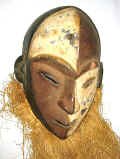
Duma Mask
Material:wood, straw
Size:21" x 11"
x 7" |
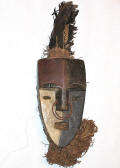
The
Duma masks are mostly polychrome. For the last half-century these masks have
been used for celebratory dances associated with major social rituals. Their
former role is less well documented.
Material: wood, tissue, feathers
Size: 14" x 4" x 2" |
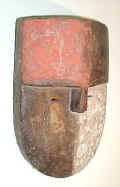
Remarkable are the
Duma masks with flat surface for face, domed forehead, an angular nose, and
skillful interplay of flat, convex, and angular forms. The masks of the Duma
are mostly polychrome. For the last half-century these masks have been used
for celebratory dances associated with major social rituals.
Material: wood
Size: 13 x 9" x 2" |
|
AMBETE
(MBETE,
MBEDE, MBETE)
Republic of
Congo, Gabon
The Mbete
claiming a Kota origin live in the middle part of the Republic of Congo
near the frontier of Gabon and in eastern Gabon. In view of the shifting
location of the peoples living in this region, it is impossible to
retrace the precise history of the Mbete culture. Certain ethnological
and sociological aspects of their life are relatively well known, and we
know that the secret societies were numerous and powerful. The Mbete do
not have any centralized political organization; they practice ancestor
worship.
They carved three types of sculpture: heads, busts and full figures.
The latter are thought to have a connection with the ancestor’s cult –
they were either used as reliquaries or placed alongside ancestor bones
in a basket. The massive reliquary figures, statues and masks of the
Mbete are cubist in structure, the stepped hair-dress having
clearly-marked gradations, and the face frequently being painted white.
Heads and busts were probably positioned on poles and placed in front
of the chief’s house. They may have had an apotropaic and emblematic
purpose. Statues are provided with a dorsal, rectangular cavity, or the
body itself may be in the shape of a reliquary chest. The relics could
be set inside the statue. The arms are often fixed to the body and the
hands and feet barely discernible.
Generally the head alone is
sculpted in the round, the arms and lower extremities only roughly
carved out. The faces of the Mbete statues show a prominent forehead
overhanging a hollow receding face with a rectangular mouth and broadly
carved features, so that the original tree-trunk form is still visible.
The shoulders are thrown forward, the arms bent. Frequently, the hairdo,
composed of horizontal loops, is parted by a central crest. |
|
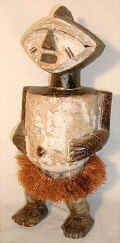
Reliquary
Statue. The Mbete are situated on the border between the Middle
Congo and Gabon, east of the Obamba. In view of the shifting location of the
peoples living in the Ogoue basin (Gabon), it is impossible to retrace the
precise history of the Mbete culture. Certain ethnological and sociological
aspects of their life are relatively well known, and we know that the secret
societies were numerous and powerful. The Mbete do not have any centralized
political organization; they practice ancestor worship, but do not employ
reliquary boxes. Instead, statues are provided with a dorsal cavity, or the
body itself may be in the shape of a reliquary chest. This figure has
definitely connection with the ancestor’s cult. The arms and hands are fixed
to the body. It is hollowed out at the back of the statue into which the
relics were placed.
Material: wood, raffia
Size: 15" x 7" x 7" |
|
ATTYE
(AKYE, AKE,
ANKYE, ATIE, ATTIE, ATYE)
Côte
d’Ivoire
The eastern coast of the Côte d'Ivoire comprises the area of lagoons.
The population here is divided into twelve different language groups
with Akye being one of them. The Akye numbering 55,000 constitute a part
of the Akan group of ethnicities. Before colonization each village was
autonomous and, when threatened, they united to form a 'confederation'.
Usually these people are not governed by chiefs, although a man's social
position is determined by his age.
Early Akan economics revolved primarily around the trade of gold and
enslaved peoples to Mande and Hausa traders within Africa and later to
Europeans along the coast. This trade was dominated by the Asante who
received firearms in return for their role as middlemen in the slave
trade. These were used to increase their already dominant power. Local
agriculture includes cocoa cultivation for export, while yams and taro
serve as the main staples. Along the coast, fishing is very important.
The depleted forests provide little opportunity for hunting. Extensive
markets are run primarily by women who maintain considerable economic
power, while men engage in fishing, hunting and clearing land. Both
sexes participate in agricultural endeavors.
Royal membership among Akan is determined through connection to the
land. Anyone who traces descendence from a founding member of a village
or town may be considered royal. Each family is responsible for
maintaining political and social order within its confines. In the past,
there was a hierarchy of leadership that extended beyond the family,
first to the village headman, then to a territorial chief, then to the
paramount chief of each division within the Asante confederacy. The
highest level of power is reserved for the Asanthene, who inherited his
position along matrilineal lines. The Asantahene still plays an
important role in Ghana today, symbolically linking the past with
current Ghanaian politics.
Akan believe in a supreme god who takes on various names depending upon
the particular region of worship. Akan mythology claims that at one time
the god freely interacted with man, but that after being continually
struck by the pestle of an old woman pounding fufu, he moved far up into
the sky. There are no priests that serve him directly, and people
believe that they may make direct contact with him. There are also
numerous gods (abosom), who receive their power from the supreme god and
are most often connected to the natural world. These include ocean and
river spirits and various local deities. Priests serve individual
spirits and act as mediators between the gods and mankind. Nearly
everyone participates in daily prayer, which includes the pouring of
libations as an offering to both the ancestors who are buried in the
land and to the spirits who are everywhere. The earth is seen as a
female deity and is directly connected to fertility and fecundity.
Woodcarving includes human statues, stools, which are recognized as
"seats" of power, wooden dolls (akua’ba) that are associated with
fertility, and also ivory and brass objects. Lost-wax casting processes
were highly developed among the Akan – both gold and brass were caste.
There are also extensive traditions of pottery and weaving throughout
Akan territory. Kente cloth, woven on behalf of royalty, has come to
symbolize African power throughout the world.
Standing and seated statues with bulbous arms and legs produced by
the Akye show strong Baule influence, but they are very marked by their
distinctive style. Often the hairdo is geometric. What is unusual is
that the relief scarification marks are achieved by insertion of small
wooden plugs into the carving. Representing the forces of female
fecundity, these statues were used in rituals to make these forces work.
This type of statue was known under the tribal name of alangua.
|
|
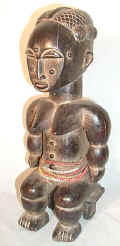
Alangua -
ceremonial female figure. The eastern coast of the
Côte d'Ivoire comprises the area of lagoons, where the population is divided
into twelve different language groups with Akye being one of them. Usually
chiefs do not govern these people, although a man's social position is
determined by his age. This statue came from the Lagoon region of the
southeastern Côte d’Ivoire and may be attributed to the Akye. The statues of
this type were used in many different ways. The figure could have been owned
by a diviner, for use in conveying messages to the spirit world, or it may
have been prescribed by the diviner to the client. Alternatively, it could
have been intended to represent (and house) a man’s ‘spirit lover’ from the
other world or it may have been displayed at certain traditional dances.
Material: wood
Size: 14" x 5" x 5" |
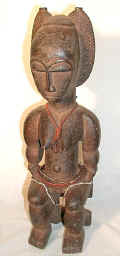
Alangua -
ceremonial female figure. The eastern coast of the Côte
d'Ivoire comprises the area of lagoons, where the population is divided into
twelve different language groups with Akye being one of them. This statue
came from this region and may be attributed to the Akye. Usually chiefs do
not govern these people, although a man's social position is determined by
his age. Widespread in Lagoon societies is the belief that when people are
born into the world they leave behind a spirit counterpart, or “lover”, in
the other world. This counterpart may become jealous and cause his or her
earthly part impotence, infertility or other misfortune. As part of the cult
individuals lavish attention on beautiful images of their spirit
counterparts. The statues of this type were used in many different ways. The
figure could have been owned by a diviner, for use in conveying messages to
the spirit world, or it may have been prescribed by the diviner to the
client. Alternatively, it could have been intended to represent (and house)
a man’s “spirit lover” from the other world or it may have been displayed at
certain traditional dances. In either case it would have been consecrated to
serve as a dwelling place for a spirit.
Material: wood
Size:
12" x 5" x 5" |
|
ASHANTI
(ASANTE,ACHANTI,
ASHANTE)
Ghana
The Asante region of southern
Ghana is a remnant of the Ashanti Empire, which was founded in the early
17th century when, according to legend, a golden stool descended from
heaven into the lap of the first king, Osei Tutu. The stool is believed
to house the spirit of the Ashanti people in the same way that an
individual's stool houses his spirit after death.
The Asante
number 1.5 million. The early Asante economy depended on the trade of
gold and enslaved peoples to Mande and Hausa traders, as well as to
Europeans along the coast. In return for acting as the middlemen in the
slave trade, the Asante received firearms, which were used to increase
their already dominant power, and various luxury goods that were
incorporated into Asante symbols of status and political office. The
forest surrounding the Asante served as an important source of kola
nuts, which were sought after for gifts and used as a mild stimulant
among the Muslim peoples to the north. In traditional Asante society, in
which inheritance was through the maternal line, a woman's essential
role was to bear children, preferably girls.
The art of
Ashanti can be classified into two main groups: metalwork (casts of
brass or gold using a lost-wax method and objects made of hammered metal
sheets) and woodcarvings. Fertility and children are the most frequent
themes in the wooden sculptures of the Asante. Thus the most numerous
works are akua’ba fertility figures and mother-and-child figures
called Esi Mansa. The acua’ba are dolls with disk-shaped
heads embodying their concept of beauty and carried by women who want to
become pregnant and to deliver a beautiful child. The fame of these
objects derives from a legend asserting that a woman who has worn one
will give birth to a particularly beautiful daughter. A Ghanaian source
indicates another use: when a child disappeared, the acua’ba
statue was placed with food and silver coins at the edge of the forest
to attract the malevolent spirit responsible: the spirit would then
exchange the child for the statue. Sculptured mother-and-child figures
show the mother nursing or holding her breast. Such gestures express
Asante ideas about nurturing, the family, and the continuity of a
matrilineage through a daughter or of a state through a son. The
mother-and-child figures are kept in royal and commoner shrines where
they emphasize the importance of the family and lineage. The Asante are
famous for their ceremonial stools carved with an arched sit set over a
foot, referring to a proverb or a symbol of wisdom. They are usually
made for a chief when he takes office and are adorned with beads or
copper nails and sheets. In rare cases, when the chief is sufficiently
important, the stool is placed in a special room following his death to
commemorate his memory. Asante chairs are based on 17th-century
European models and, unlike stools, do not have any spiritual function.
They are used as prestige objects by important chiefs during festivities
or significant gatherings.
Also
are produced staffs for royal spokesmen, which, like the handles of
state swords, are covered in gold foil. The success of the Ashanti
Empire depended on the trade in gold not only with Europeans at the
coast but also with the Muslim north. Gold dust was the currency,
weighed against small brass weights that were often geometric or were
representations recalling well-known proverbs. Asante weavers developed
a style of weaving of great technical mastery, incorporating imported
silk. The Asante developed remarkably diverse kuduo containers
cast of copper alloys. Kuduo were used in many ways. They held
gold dust and other valuables, but could also be found in important
political and ritual contexts. Some kuduo were buried with their
owners, while others were kept in the palace shrine rooms that housed
the ancestral stools of deceased state leaders. Life and the afterlife,
the present and the past, were enhanced and made more meaningful by the
presence of these elegant prestige vessels. The Asante also cast fine
gold jewelry, as do the Baule of Côte d'Ivoire, who separated from them
in the mid-18th century. The deceased are honored by fired-clay memorial
heads. |
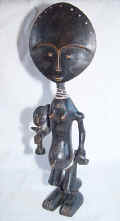
Akua’ba
Doll
Material: wood
Size: 18" x 6" x 5" |
Akua’ba Dolls. In traditional Ashanti society, in
which inheritance was through the maternal line, a woman's essential role
was to bear children, preferably girls to continue the matrilineage.
Fertility and children are the most frequent themes in the wooden sculptures
of the Asante. Such are akua’ba fertility figures. The akua’ba
are dolls with disk-shaped heads embodying their concept of beauty
and carried by women who want to become pregnant and to deliver a beautiful
child. A Ghanaian source indicates another use: when a child disappeared,
the akua’ba statue was placed with food and silver coins at the edge
of the forest to attract the malevolent spirit responsible: the spirit would
then exchange the child for the statue. |
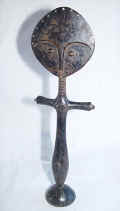
Akua’ba
Doll
Material: wood
Size: 14" x 4" x 3"
|
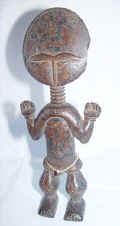
Akua’ba
Doll
Material: wood
Size: 12" x 6' x 3" |
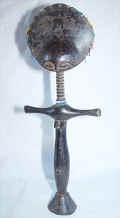
Akua’ba
Doll
Material: wood
Size: 16" x 6" x 2" |
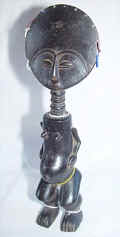
Akua’ba
Doll
Material: wood
Size: 14" x 5" x 4" |
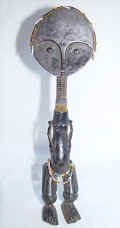
Akua’ba
Doll
Material: wood
Size: 13" x 3" x 3" |
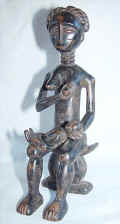
Maternity
figure. Fertility and children are the most frequent themes in the
wooden sculpture of the Asante. Thus the most numerous works are acua’ba
fertility dolls and mother-and-child figures. In traditional Ashanti
society, in which inheritance was through the maternal line, a woman's
essential role was to bear children, preferably girls to continue the
matrilineage. Such figures show the mother nursing or holding her breast, as
exemplified by this figure. Such gestures express Asante ideas about
nurturing, the family, and the continuity of a matrilineage through a
daughter or of a state through a son. The sculptural emphasis on the child’s
nourishment and security may refer at the same time to the dependence of
each individual on the matrilineage.
Material: wood
Size:
13" x 5" x 6" |
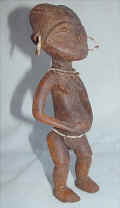
Mmoatia
or “fairy-tale” figure. The Asante region of southern Ghana is a
remnant of the Ashanti Empire, which was founded in the early 17th century
when; according to legend, a golden stool descended from heaven into the lap
of the first king, Osei Tutu. Asante was the largest and most powerful of a
series of states formed in the forest region of southern Ghana by people
known as the Akan. Among the factors leading the Akan to form states,
perhaps the most important was that they were rich in gold. The stretch of
the Atlantic coast now in Ghana became known in Europe as the Gold Coast.
Rather naturalistically carved wood figures in various positions were used
to illustrate legends or stories. They are called mmoatia or
“fairy-tale” figures. The present figure belongs to this group.
Material : wood
Size: 8" x 3" x 2 " |
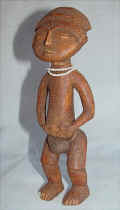
Mmoatia
or “fairy-tale” figure. The Asante region of southern Ghana is a
remnant of the Ashanti Empire, which was founded in the early 17th century
when; according to legend, a golden stool descended from heaven into the lap
of the first king, Osei Tutu. Asante was the largest and most powerful of a
series of states formed in the forest region of southern Ghana by people
known as the Akan. Among the factors leading the Akan to form states,
perhaps the most important was that they were rich in gold. The stretch of
the Atlantic coast now in Ghana became known in Europe as the Gold Coast.
Rather naturalistically carved wood figures in various positions were used
to illustrate legends or stories. They are called mmoatia or
“fairy-tale” figures. The present figure belongs to this group.
Material : wood
Size: 9" x 3" x 2"
|

Kuduo
box. Inspired by 14th- and 15th century
Arabic-inscribed basins from Mameluk Egypt and other imported Islamic items,
Asante metal casters also drew upon European trade wares in the creation of
luxury containers named kuduo. Possession of elaborately decorated
kuduo was the prerogative of highly positioned chiefs, who used them to
store their treasures, gold dust, and precious beads. Kuduo were also
used to keep sacred objects or sacrificial foods. The lid of this kuduo
and its walls are dominated by bas-reliefs rendering of crocodiles. Some
kuduo were buried with their owners, while others were kept in the
shrine rooms. Life and the afterlife, the present and the past, were
enhanced and made more meaningful by the presence of these elegant prestige
vessels.
Material: copper
alloy
Size: |
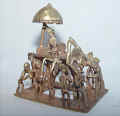
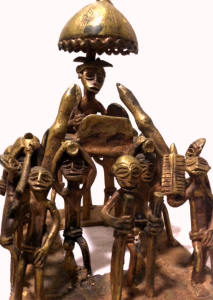 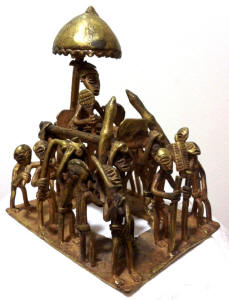 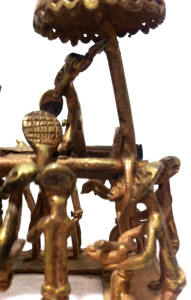 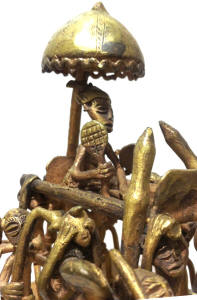
Scene from a
legend. The Asante region of southern Ghana is a remnant of the
Ashanti Empire, which was founded in the early 17th century when; according
to legend, a golden stool descended from heaven into the lap of the first
king, Osei Tutu. Asante was the largest and most powerful of a series of
states formed in the forest region of southern Ghana by people known as the
Akan. Among the factors leading the Akan to form states, perhaps the most
important was that they were rich in gold. The stretch of the Atlantic coast
now in Ghana became known in Europe as the Gold Coast. Rather
naturalistically cast figures or scenes were used to illustrate legends or
stories. The present scene is one of them.
It depicts a
procession at a royal festival. The chief is riding in a palanquin under an
umbrella. He must be a person of high status because he is not walking, but
is being carried by 4 carriers and his procession is led by the bearer of
chief's staffs of prestige. The chief is wearing an elaborate head gear, and
he is holding a fly-whisk in his right - presumably to gesture to the
crowds. Included in the procession are a body guard with his sword held
high, musicians with percussive and wind instruments and a dancer with a
mask on the top of his head. The chief is being fanned by a large fan.
Material: brass
Size: 7" x 5" x 4"
THIS ITEM HAS BEEN SOLD
|
| |
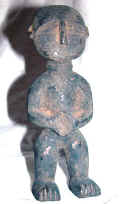
This item has been sold
This figurine has flattened head, and facial features
traditional for Ashanti. Purchased by Dr. Raskin near the sacred lake
Bostontwi in Ghana during one of his visits to the area. in the late
1990ies. The lake is so sacred that tribesmen who are fishing or boating on
it are not allowed to use ores and have to row with their hands. There are
very important Ashanti shrines in the area. The figure comes from one of the
villages near a shrine.
Material: wood
size: 6" x 2.5" x 1" |
|
|
|
| |
|
|
|
|
|
BAGA
Guinea and
Guinea-Bissau
Today, the Baga people, 60,000
in total, occupy the northern coast of Guinea and the southern coast of
Guinea-Bissau. They live in the marshy area flooded six months of the
year, during which time the only way to get around is by a dugout canoe.
They live in villages divided into two to four quarters, which are in
turn divided into five or six clans. Traditionally, the village is
headed by the eldest member of each clan.
The Baga are farmers; women primarily
cultivate swamp varieties of rice in wet paddies along the coast.
Cotton, gourds, millet, oil palms, okra, sesame, and sorghum are locally
grown products that help to round out the Baga diet.
The men also fish and grow cola nuts.
Spiritually, they believe in a single god, known as
Kanu,
assisted by a male and female spirits. The only fundamental ritual is
initiation. Before burial, the dead are displayed in a sacred wood and
their belongings are buried.
Baga had rich traditions of
multifunctional masks and sculpture, many of which were suppressed with
the advent of Islam. The best known of these is the massive Nimba (or
Dumba) mask, with its great cantilevered large nose, a large pair of
breasts, crested head supported
on the upper part of a female torso, carved so as to rest on the
shoulders of the wearer, his body hidden in raffia fiber. The mask can
also stand on four legs. Sterile women in the Simo secret society
invoked it as the Mother of Fertility, and it was used at the
first-fruit (rice) rituals, symbolically associating female fertility
with the increase of the grain. This mask appears at the harvest and
threshing of the rice crop, is worn by dancers at birth, marriages and
other joyful ceremonies. This mask represented the very essence of Baga
dignity and culture. The Simo society utilized very large polychrome
masks (often more than 5 feet tall), known as banda or boke
which are used in fertility rituals by this society, played a part
during the dry season, after the rice harvest, and at funerals. It has
an elongated human face with the jaws of a crocodile, the horns of an
antelope, the body of a serpent and the tail of a chameleon.
Baga craftsmen also carve
anok, a-tscol or elek, bird heads with human features that
were used at harvest time and funerary rites, also by the members of the
Simo society. Every family owns an elek, which is part of the family
shrine, together with other objects: stones, vine twigs and bark
reddened by cola nuts, dead scorpions or jaws of crabs, and a fly
swatter, important for purification ceremonies and indispensable in the
hunt for witches. The elek represents the lineage of which it is
protector and the most visible sign. It punishes the guilty, for it
a;one is able to pursue witches wherever they may be.
Baga snake headpiece can be up
to 260 cm high and typically display undulation, polychrome decoration
and sometimes have eyes inset with glass. It is an emblem of Bansonyi,
men’s secret association. This headpiece, also called bansonyi,
presents a python standing upright. Bansonyi lives in the sacred forest
and emerges when it is time to begin the boys’ coming-of-age rites. As
receptacle for the most powerful spirit, bansongyi is believed to
be the strongest adversary of sorcery and destructive forces that could
endanger the well-being of the village. Bansongyi also appears at
the funeral celebrations of the most important members of the community.
They were held on the shoulders of a dancer. There are also other masks
combining human and animal features.
The Baga also produced statues
on round columns, called tambaane, tsakala, or kelefa:
extremely large head, compressed on both sides, in angular, stylized
construction; jutting nose; arms without hands, or hands resting under
the chin. They were kept in round huts by the Simo society.
Tall drums supported by a human
figure are also carved. |
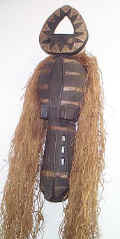
Tonkongba headdress. The
Tonkongba headdress can be seen as a three-part form, including a
helmet in the center, a long snout protruding from the front, and, a pair of
flat horns usually connected at their tips. It is not known much about the
use of these headdresses. Our knowledge concerning the Tonkongba’s
function is complicated by a number of factors, including the extreme
secrecy enveloping the sculpture and the probability that it was used in
different ways by different groups. No doubt, it served both as a shrine
figure and as a dance headdress. According to some sources, the Tonkongba
appeared on any special occasion when a sacrifice was involved, for example,
at a funeral. It danced at sunrise. When Tonkongba came out, the
people would hang tobacco leaves and fowl on its costume as tribute.
Material: wood
Size: 35" x 10" x 7"
|
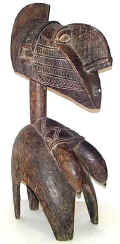
Nimba
(d’mba) mask.
The various peoples known as Baga and numbering some 65,000
occupy a narrow stretch of marshy lowland along the
Atlantic lagoons of the Republic of Guinea. They grow rice in the marshy
area flooded six months of the year, during which time the only way to get
around is by a dugout canoe. The men also fish and grow cola nuts. They
believe in a single god who is assisted by a male and a female spirit. The
nimba masks are among the most imposing of all African masks. It
represents the idea of the fertile woman. The exaggerated, pendulous breasts
are typical for these masks, which had a double function: sterile women in
the Simo society invoked it as a goddess of fertility, and it was
used at the first-fruit (rice) rituals, symbolically associating female
fertility with the increase of the grain. The masks are used by dancers at
birth, marriages, harvest festivals and other joyful ceremonies.
Material: wood
Size: 40" x 21" x 12"
|
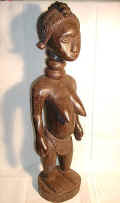
Female Figure.
The various peoples known as Baga and numbering some 65,000
occupy a narrow stretch of marshy lowland along the Atlantic lagoons of the
Republic of Guinea. This marshy
area is flooded six months of the year, during which time the only way to
get around is by a dugout canoe. Their villages are traditionally headed by
the eldest members of each clan. The men fish and grow cola nuts; the women
grow rice. Spiritually, they believe in a single god, known as
Kanu,
assisted by a male and female spirits. The only fundamental ritual is
initiation. The female figure is important in Baga art. This standing figure
of rather naturalistic form represents an initiated young woman. Female
figures of this type were used by many of the adult women’s organizations.
Material: wood
Size:
39" x 10" x 10"
|
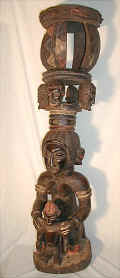
Female drum (a-ndef). Among the
Baga female power is demonstrated in drums that are carved in the form of a
kneeling woman who supports the instrument. Owned by the woman’s A-Teken
organization, such drums are played by women at annual initiations, the
funerals of association members, their daughters’ weddings, and the
reception of distinguished visitors. The woman supporting the drum reflects
the female role as “bearer” in Baga culture. Women carry on their heads huge
clay vessels filled with water and large baskets of rice. Among the northern
Baga, the a-ndef , the large cariatide drums with the small drum
barrel were the exclusive property of women’s a-Tekan association.
Material: wood
Size: 44" x 11" x 12"
|

Bansonyi headpiece.
Today, the Baga people, 60,000 in total, occupy the northern coast of Guinea
and the southern coast of Guinea-Bissau. Bansonyi is the man’s secret
society that unites autonomous villages of the Baga people. Its emblem is a
polychrome headpiece, called Bansonyi that is carved in the form of a
python standing upright. It embodies the snake-spirit a-Mantsho-na-Tshol
(“master of medicine”). Among most Baga subgroups, only adolescent males
learn the secrets of the snake-spirit during the initiation, which marks the
passage to adult status. Bansonyi lives in the sacred forest and
emerges when it is time to begin the boys’ coming-of-age rites. Bansonyi
is believed to be the strongest adversary of sorcery and destructive forces
that could endanger the well-being of the village. It is especially
protective of the boys during their initiation into adult society.
Bansonyi also appear at the funeral celebrations of the most important
members of the community.
Material: wood
Size:43" x 7" x 6" |
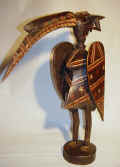
Elek (composite figure of bird and
human). (???, may be Senufo)
Every Baga family owns an elek, named also
anok
or a-tscol, which is part of the family shrine,
together with other objects: stones, vine twigs and bark reddened by cola
nuts, dead scorpions or jaws of crabs. Eleks are
bird birds with human features that were
used at harvest time and funerary rites, also by the members of the Simo
society. Activated by sacrifices, the elek are
regularly brought out at night. It punishes the guilty, for it alone is able
to pursue witches wherever they may be. This elek is a particularly well
preserved and intricately carved example of Baga sculpture.
Material: wood
SOLD
Size:
26" x 23" x 7" |
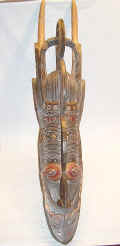
A Monumental Banda or boke mask.
The only fundamental ritual
among the Baga is initiation. These people had rich traditions of
multifunctional masks and sculpture, many of which were suppressed with the
advent of Islam. The Simo society utilized very large polychrome masks
(often more than 5 feet tall), known as banda or boke which
were used in fertility rituals by this society, played a part during the dry
season, after the rice harvest, and at other occasions. The banda mask
represents a high rank in the Simo society, and is feared
accordingly. It is worn on the head, horizontally and at a slant. At its
approach all those not initiated flee horror-struck into their huts for
protection. This mask is an elegant composite of animal and human features,
including the jaw of a crocodile, the face and coiffure of a human being,
the horns of an antelope, the body of a snake, and the curling tail of a
chameleon.
Material:
wood
Size:
55" x 15" x 10"
Similar mask sold at Bonhams May 13, 2010 Auction
$12,000
Similar masks described in Art of the Baga by Frederik
Lamp pp 144-149 |
|
BAMBARA
(BAMANA,
BANMANA)
Mali
The Bambara numbering 2,500.000 million form the largest ethnic
group within Mali. The triangle of the Bambara region, divided in two
parts by the Niger River, constitutes the greater part of the western
and southern Mali of today. The dry savanna permits no more than a
subsistence economy, and the soil produces, with some difficulty, corn,
millet, sorghum, rice, and beans. Their traditions include six male
societies, each with its own type of mask. Initiation for men lasts for
seven years and ends with their symbolic death and their rebirth.
The ntomo society is for young boys before circumcision.
There are two main style groups of their masks. One is characterized by
an oval face with four to ten horns in a row on top like a comb, often
covered with cowries or dried red berries. The other type has a ridged
nose, a protruding mouth, a superstructure of vertical horns, in the
middle of which or in front of which is a standing figure or an animal.
The komo is the custodian of tradition and is concerned
with all aspects of community life -- agriculture, judicial processes,
and passage rites. Its masks are of elongated animal form decorated with
actual horns of antelope, quills of porcupine, bird skulls, and other
objects. Their headdress, worn horizontally, consists of an animal,
covered with mud, with open jaw; often horns and feathers are attached.
Masks of the kono, which enforces civic morality, are also
elongated and encrusted with sacrificial material. The kono masks
were also used in agricultural rituals, mostly to petition for a good
harvest. They usually represent an animal head with very long open snout
and long ears standing in a V from the head, often covered with mud.
The tji wara (Tji wara)
society members use a headdress representing, in the form of an
antelope, the mythical being who taught men how to farm. The word tji
means “work” and wara means “animal,” thus “working animal.”
There are male and female antelopes with vertical or horizontal
direction of the horns. The dancers appeared in pairs (a man and a woman
– an association with fertility) holding two sticks in their hands,
their leaps imitating the jumps of the antelopes.
The kore, representing the highest level concerned with
the sky and with the bringing of rain to make the crops grow, employs
masks representing the hyena, lion, monkey, antelope, and horse. In
addition there are masks of the nama, which protect against
sorcerers.
The size of the statue may vary from 12 inches to 4 feet. The
figures are usually standing or sitting females with a dignified air,
some holding a child. Some have the arms separated from the body, flat
palms facing forward, the hands sometimes attached to the thighs. They
may have crest-like hairdos with several braids falling on their
breasts. In the same style, representations of musicians and of
lance-carrying warriors are found. There are also carvings with Janus
head. Ancestor figures of the Bambara clearly derive from the same
artistic tradition as do many of those of the Dogon. Rectangular
intersection of flat planes is a stylistic feature common to Bambara and
Dogon sculpture. |
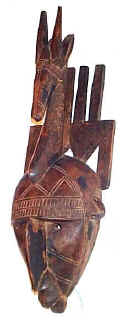
Kore antelope mask.
The 1.9 to 2.5
million Bambara live in the region
around Bamako, the capital of Mali. They form the largest
ethnic group within the country. The Bambara live principally from
agriculture, with some subsidiary cattle rearing in the north of their
territory. The Bambara have a very complex cosmology.
They believe in existence
of spiritual forces, which are activated by individuals, who are capable to
create an atmosphere of harmony. They excelled in three types of sculpture:
stylized antelope headdresses, statues, and masks. This antelope mask is
associated with the Kore men’s secret society which organized young
farmers.
This society employs masks representing the hyena, lion, monkey,
antelope, and horse.
The mask functioned at agricultural activity
such as supplication for rain. The Kore society seems to be
disappearing in Bambara communities.
Material: wood Size: 26" x 10" x 8" |
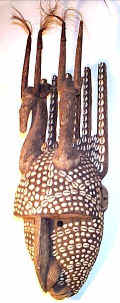
Kore antelope mask.
The 1.9 to 2.5
million Bambara live in the region
around Bamako, the capital of Mali. They form the largest
ethnic group within the country. The Bambara live principally from
agriculture, with some subsidiary cattle rearing in the north of their
territory. The Bambara have a very complex cosmology.
They believe in existence
of spiritual forces, which are activated by individuals, who are capable to
create an atmosphere of harmony. They excelled in three types of sculpture:
stylized antelope headdresses, statues, and masks. This antelope mask is
associated with the Kore men’s secret society which organized young
farmers.
This society employs masks representing the hyena, lion, monkey,
antelope, and horse.
The mask functioned at agricultural activity
such as supplication for rain. The Kore society seems to be
disappearing in Bambara communities.
Material: wood,
cowries,
animal hair
Size: 31" x 10 " x 8"
|

Dyonyeni female figure.
The Bambara excelled in three types
of sculpture: stylized antelope headdress, statues, and masks. The basic
characteristic of all their carvings is the use of bold volumes, often in
angular interplay, with semiabstract over-all composition.
The dyonyeni female figures are thought to be associated with either
the Dyo or the Kwore society. For the Bambara, the mother
figure is the embodiment of Faro, the goddess of water and mother of
all mankind. She manifests herself in rain and rainbow, or thunder and
lightning. The figures usually have geometrical features such as large
conical or rounded breasts. The blacksmith members of the Dyo society
used them during dances to celebrate the end of the initiation ceremonies.
They were handled, held by dancers and placed in the middle of the
ceremonial circle.
Material: wood
Size: 44" x 10" x 9" |
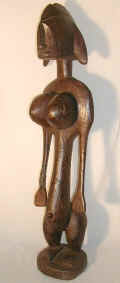
Female figure (joneyeleni or nyeleni).
While creating such freestanding figures depicting nubile young women, the
sculptors portrayed the Bambara symbolic ideal of feminine beauty. The
figures are rubbed with oil, clothed and adorned with beads and other
ornaments to resemble Bambara women dressed for festive occasions. Sculpted
figures of this type were used in the context of Jo activities. Jo was a
traditional institution concerned with maintaining social, spiritual and
economic harmony within the community. Unlike other Bambara institutions,
women as well as men were members. Newly initiated male youths displayed the
nyeleni figures during performances of Jo songs and dances.
Material: wood
Size: 34" x 7" x 9" |
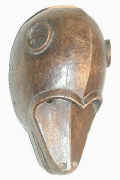
Kore
monkey mask.
The
Bambara
live in the region around Bamako, the
capital of Mali. They form the largest ethnic group within
the country. The Bambara maintain many of their ancient religious rites,
which are principally concerned with agriculture.
The masks of the Bambara can be classified
according to the secret societies in which they were used, namely the
N’tomo, Kore, Kono, and Komo. Through the six
levels of education the initiate learns the importance of knowledge and
secrecy, is taught to challenge sorcery, and learns about the dual nature of
mankind, the necessity for hard labor in the production of crops, and the
realities of surviving from day to day.
The Kore society, concerned with the
sky and with the bringing of rain to make the crops grow, employs masks
representing the hyena, lion, monkey, antelope, and horse. This monkey mask
is one of them.
Material: wood
Size:
11" x 9" x 5" |
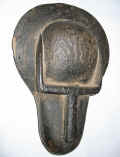
Material: wood
Size: 15" x 8" x 3" |
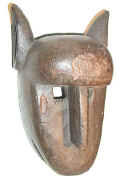
Hyena mask. The Bambara are dignified
people, proud of their warlike past. Nowadays they live principally from
agriculture, with some subsidiary hunting and cattle rearing in the northern
part of their territory. They strongly uphold their ancient tribal customs
against Islam and Christianity. This is a hyena mask used by the
agricultural Kore society. The Kore society is a rigidly
stratified male initiation group that seeks to bring men to peace with their
spirits. Its members achieved a degree of spiritual knowledge that enabled
them to experience a mystic union with divine power and enter a perpetual
cycle of reincarnation. The hyena was the society’s guardian animal. It
symbolizes fallible human wisdom. The masks of this type were used both at
initiations and at agricultural festivities, in supplications for the
fecundity of the earth and sometimes for rain.
Material: wood
Size: 12" x 7" x 6" |

Male Tji wara (antelope headdress).
The Bambara, largest and most powerful tribe in
the Western Sudan live in the open savanna to the southwest of the Dogon.
Though they are Moslem, they maintain many of their ancient religious rites,
which are principally concerned with agriculture and the fertility of the
land. Among
the best known of the Bambara associations is the Tji Wara. In the
past the purpose of the Tji Wara association was to encourage
cooperation among all members of the community to ensure a successful crop.
In recent time, however, the Bambara concept of tji wara has become
associated with the notion of good farmer, and the tji wara
masqueraders are regarded as a farming beast. The Bambara sponsor farming
contests where the tji wara masqueraders perform. Always performing
together in a male and female pair, the coupling of the antelope
masqueraders speaks of fertility and agricultural abundance. According to
one interpretation, the male antelope represents the sun and the female the
earth. The antelope imagery of the carved headdress was inspired by a
Bambara myth that recounts the story of a mythical beast (half antelope and
half human) that introduced agriculture to the Bambara people. The dance
performed by the masqueraders mimes the movements of the antelope.
Material: wood
SOLD
Size: 27" x 14" x 4" |
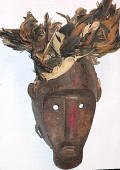
Very rare in Bambara
masks human features are without animal attributes and feathers are not
typical.
Material: wood, feathers
Size: 14" x 6" x 6" |
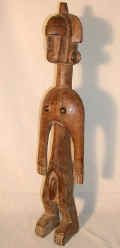
Male figure. No description
Material: Wood
Size:25" x 7" x
4" |
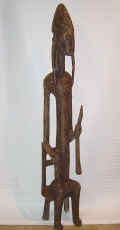
Seated male figure
Material: wood
Size: 53" x 9" x 8"
|
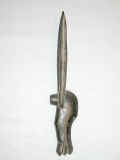
Possibly a part of tji wara
Material: wood
Size: 20" x 3" x 4"
|
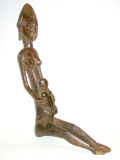
Seated mother-and-child figure (gwandusu).
The basic characteristic of Bambara carvings is the use of bold volumes,
often in angular interplay, with semiabstract over-all composition.
Gwan was a Bambara society concerned with human fertility
and childbearing. Its Major female figure was a woman holding a baby; the
name of this figure, gwandusu, is said to mean “one who has strength
and can achieve greatness.” The position of this mother-and-child figure
sitting on the ground is rare.
Material: wood
Size: 25" x 14" x 4"
|
 Kore
antelope mask. The
Bambara live in the
region around Bamako, the capital of Mali. They form the
largest ethnic group within the country. The Bambara live principally from
agriculture, with some subsidiary cattle rearing in the north of their
territory. The Bambara have a very complex cosmology.
They believe in existence
of spiritual forces, which are activated by individuals, who are capable to
create an atmosphere of harmony. They excelled in three types of sculpture:
stylized antelope headdresses, statues, and masks. This antelope mask is
associated with the Kore men’s secret society which organized young
farmers.
This society employs masks representing the
hyena, lion, monkey, antelope, and horse.
The mask functioned at agricultural
activity such as supplication for rain. The Kore society seems to be
disappearing in Bambara communities. Kore
antelope mask. The
Bambara live in the
region around Bamako, the capital of Mali. They form the
largest ethnic group within the country. The Bambara live principally from
agriculture, with some subsidiary cattle rearing in the north of their
territory. The Bambara have a very complex cosmology.
They believe in existence
of spiritual forces, which are activated by individuals, who are capable to
create an atmosphere of harmony. They excelled in three types of sculpture:
stylized antelope headdresses, statues, and masks. This antelope mask is
associated with the Kore men’s secret society which organized young
farmers.
This society employs masks representing the
hyena, lion, monkey, antelope, and horse.
The mask functioned at agricultural
activity such as supplication for rain. The Kore society seems to be
disappearing in Bambara communities.
Material: wood
Size: 32" x 8" x 9" |
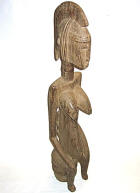
Dyonyeni female figure.
The Bambara excelled in three types
of sculpture: stylized antelope headdress, statues, and masks. The basic
characteristic of all their carvings is the use of bold volumes, often in
angular interplay, with semiabstract over-all composition.
The dyonyeni female figures are thought to be associated with either
the Dyo or the Kwore society. For the Bambara, the mother
figure is the embodiment of Faro, the goddess of water and mother of
all mankind. She manifests herself in rain and rainbow, or thunder and
lightning. The figures usually have geometrical features such as large
conical or rounded breasts. The blacksmith members of the Dyo society
used them during dances to celebrate the end of the initiation ceremonies.
They were handled, held by dancers and placed in the middle of the
ceremonial circle.
Material: wood
Size: 38" x 10" x 8" |
|
BASSA
Liberia
The Bassa, one of the largest Kru-speaking
peoples in the central coastal region and adjacent hinterland of
Liberia, have been strongly influenced by the Mende-speaking neighbors,
especially the Dan and Kpelle. Their economy is based on rice which they
cultivate around small villages which have a population around two
hundred. Bassa artistic tradition has been also influenced by their
north-eastern neighbors, the Dan, who live on the Côte d’Ivoire. The
Bassa have several female and male societies, including chu-den-zo,
to whom gela (geh-naw) masks belong. Bassa carvers are
famed for their gela masks worn during
the no men's society ceremonies when
the wearer of the mask moves with feminine and elegant grace. The
masqueraders entertain the spectators when initiated boys return from
bush camp, when important guests visit the village, and on other festive
occasions. The dancer wears the mask, which is attached to a woven
framework, on his forehead, and looks through a slit in the fabric which
is part of the costume that covers his head and upper body. Because they
are fixed on a framework, the interior of most such masks shows no signs
of wear.
Bassa sculptures also bare similarity to
Dan and display monumental and solemn qualities combined with skillful
carving. Figures of dogs carved with a human face on the side, as well
as stools, are known to exist, although the purpose of the dog statue
remains unknown. |
|
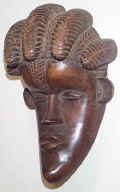
Geh-naw ceremonial mask.
Bassa artistic tradition has been influenced by their northeastern
neighbors, the Dan. With graceful, gliding dances the geh-naw
masqueraders entertain the spectators when initiated boys return from bush
camp, when important guests visit the village, and on other festive
occasions. The dancer wears the mask, which is attached to a woven
framework, on his forehead, and looks through the slit in the fabric, which
is part of the costume that covers his head and upper body. The geh-naw
masks are public entertainers who perform when the boys return from the bush
schools, but also on many other occasions, such as the visits of important
guests or on public holidays. The mask is intended to convey a sense of
grace and serenity.
Material: wood
Size: 10" x 7" x 3"
|
|
BAULE
(BAOULE,
BAWULE)
Côte d'Ivoire
The Baule people, known as one of the largest ethnic group in
the Côte d'Ivoire, have played a central role in twentieth-century
Ivorian history. They waged the longest war of resistance to French
colonization of any West African people, and maintained their
traditional objects and beliefs longer than many groups in such constant
contact with European administrators, traders, and missionaries.
According to a legend, during the eighteenth century, the queen, Abla
Poku, had to lead her people west to the shores of the Comoe, the land
of Senufo. In order to cross the river, she sacrificed her own son. This
sacrifice was the origin of the name Baule, for baouli means “the
child has died.” Now about one million Baule occupy a part of the
eastern Côte d'Ivoire between the Komoé and Bandama rivers that is both
forest and savanna land. Baule society was characterized by extreme
individualism, great tolerance, a deep aversion toward rigid political
structures, and a lack of age classes, initiation, circumcision,
priests, secret societies, or associations with hierarchical levels.
Each village was independent from the others and made its own decisions
under the presiding presence of a council of elders. Everyone
participated in discussions, including slaves. It was an egalitarian
society. The Baule compact villages are divided into wards, or quarters,
and subdivided into family compounds of rectangular dwellings arranged
around a courtyard; the compounds are usually aligned on either side of
the main village street. The Baule are agriculturists; yams are the
staple, supplemented by fish and game; coffee and cocoa are major cash
crops. The importance of the yam is demonstrated in an annual harvest
festival in which the first yam is symbolically offered to the
ancestors, whose worship is a prominent aspect of Baule religion. The
foundation of Baule social and political institutions is the matrilineal
lineage; each lineage has ceremonial stools that embody ancestral
spirits. Paternal descent is recognized, however, and certain spiritual
and personal qualities are believed to be inherited through it. The
Baule believe in an intangible and inaccessible creator god, Nyamien.
Asie, the god of the earth, controls humans and animals. The spirits, or
amuen, are endowed with supernatural powers. Religion is founded
upon the idea of death and the immortality of the soul. Ancestors are
the object of worship but are not depicted.
Baule art is sophisticated and stylistically diverse. Non
inherited, the sculptor’s profession is the result of a personal choice.
The Baule have types of sculpture that none of the other Akan peoples
possess. Wooden sculptures and masks allow a closer contact with the
supernatural world. Baule statues are usually standing on a base with
legs slightly bent, with their hands resting on their abdomen in a
gesture of peace, and their elongated necks supporting a face with
typically raised scarification and bulging eyes. The coiffure is always
very detailed and is usually divided into plaits. Baule figures answer
to two types of devotion: one depicts the “spiritual” spouse who, in
order to be appeased, requires the creation of a shrine in the personal
hut of the individual. A man will own his spouse, the blolo bian,
and a woman her spouse, the blolo bla. The Baule believe that
before they were born into the world they existed in a spirit world,
where each one had a mate. Sometimes that spirit mate becomes jealous of
their earthly mate and causes marital discord. When this happens, a
figure depicting the other world spouse is carved and placated with
earthly signs of attention.
The Baule are also noted for their fine wooden sculpture,
particularly for their ritual figures representing spirits; these are
associated with the ancestor cult. The Baule have also created monkey
figures gbekre that more or less
resemble each other. Endowed with prognathic jaw and sharp teeth and a
granular patina resulting from sacrifices, the monkey holds a bowl or a
pestle in its paws. Sources differ on its role or function: some say it
intervenes in the ritual of divination, others that it is a protection
against sorcerers, or a protective divinity of agrarian rites, or a bush
spirit. The figures and human masks are elegant -- well polished, with
elaborate hairdressings and scarification.
Masks correspond to three types of dances: the gba gba,
the bonu amuen, and the goli. They never represent the
ancestors and are always worn by men. The gba gba is used at the
funerals of women during the harvest season. It celebrates beauty and
age, hence its refined features. The double mask represents the marriage
of the sun and the moon or twins, whose birth is always a good sign. The
bonu amuen protects the village from external threats; it obliges
the woman to a certain discipline; and it appears at the commemorations
of death of notables. When they intervene in the life of the community,
they take the shape of a wooden helmet that represents a buffalo or
antelope and which is worn with a raffia costume and metal ankle
bracelets; the muzzle has teeth which incarnate the fierce animal that
is to defend the group. The very characteristic, round-shaped “lunar”
goli is surmounted by two horns. Celebrating peace and joy, they
would sing, dance, and drink palm wine. In the procession, the goli
preceded the four groups of dancers, representing young adolescents. The
goli would be used on the occasion of the new harvest, the visit
of dignitaries, or at the funerals of notables. Boxes for the mouse
oracle (in which sticks are disturbed by a live mouse, to give the
augury) are unique to the Baule, whose carvers also produce heddle
pulleys, combs, hairpins, and gong mallets. |
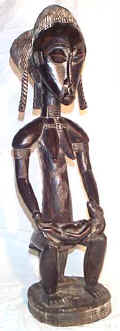
Female bush spirit figure or mbra.
Around 1 million Baule occupy a part of the central Cote d’Ivoire that is
both forest and savanna land. They came to this territory in the 18th
century, an area previously the home of Guro.
Statues were mostly
used for two purposes: the first was to incarnate a spirit of the bush,
asie usu or mbra; the second was to represent a spouse from the
other world, blolo bla or blolo bian.
According to
the Baule beliefs,
Asie usu (mbra) are extravagant
creatures that live in the bush and occasionally make contacts with human
beings. They are male and female, have colorful personalities, and often
have personal names. Therefore their figures are made in pairs. These
spirits are mischievous, but, if properly honored, will grant fruitful
harvests and hunts. They sometimes express desire, through the village
diviner, to be associated with a specific person. A figure is then sculpted
and worshipped in the house of the designated individual.
Material: wood
Size: 25" x 8" x 7"
|
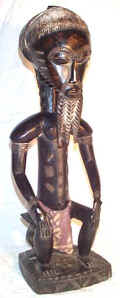
Baule (Baoule, Bawule)
Côte
d’Ivoire
Male bush
spirit figure or mbra.
Baule statues were mostly used for two
purposes: the first was to incarnate a spirit of the bush, mbra or
asie usu; the second was to represent a spouse from the other world.
According to
the Baule beliefs,
mbra live in the bush and occasionally
make contacts with human beings. They are male and female, have colorful
personalities, and often have personal names. Therefore their figures are
made in pairs. Mbra is a Baule cult used for divination. Only certain
families have mbra, having acquired it in past generation. These
spirits are mischievous, but, if properly honored, will grant fruitful
harvests and hunts. They sometimes express desire, through the village
diviner, to be associated with a specific person. A figure is then sculpted
and worshipped in the house of the designated individual.
Material: wood,
cloth
Size: 23" x 8" x 8"
|
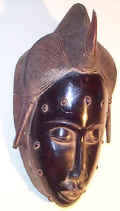
Mblo
dance mask.
The Baule people occupy a
part of the Côte d'Ivoire between the Komoé and Bandama Rivers that is both
forest and savanna land. Baule society was characterized by extreme
individualism, great tolerance, a deep aversion toward rigid political
structures, and a lack of age classes, initiation, circumcision, priests,
secret societies, or associations with hierarchical levels. Each village was
independent from the others and made its own decisions under the presiding
presence of a council of elders. Everyone participated in discussions,
including slaves. It was an egalitarian society. Ancestors are the object of
worship but are not depicted. This
type of masks used in mblo dances is one of the oldest of Baule art
forms. These dances offer psychological relief in times of stress. The mask
is usually a portrait of a particular known individual. Lustrous curving
surfaces, suggesting clean, healthy skin, are set off by delicately textured
zones representing coiffures, scarifications, and other ornaments. The faces
are idealized.
Material: wood
Size: 16" x 9" x 5"
|
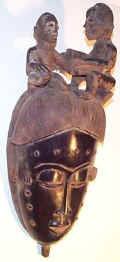
Mblo
dance mask. The
Baule people occupy a part of the Côte d'Ivoire between the Komoé and
Bandama Rivers that is both forest and savanna land. Baule society was
characterized by extreme individualism, great tolerance, a deep aversion
toward rigid political structures, and a lack of age classes, initiation,
circumcision, priests, secret societies, or associations with hierarchical
levels. Each village was independent from the others and made its own
decisions under the presiding presence of a council of elders. Everyone
participated in discussions, including slaves. It was an egalitarian
society. Ancestors are the object of worship but are not depicted.
This type of masks used in mblo dances
is one of the oldest of Baule art forms. These dances offer psychological
relief in times of stress. The mask is usually a portrait of a particular
known individual. Lustrous curving surfaces, suggesting clean, healthy skin,
are set off by delicately textured zones representing coiffures,
scarifications, and other ornaments. The faces are idealized.
Material: wood
Size: 21" x 9" x 5"
|
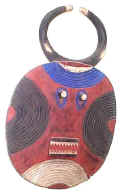
Kplekple
mask. This mask belongs to a group of
various types of masks known as goli. Goli is a day-long
spectacle that normally involves the whole village and includes, besides the
appearance of masks, music played on special instruments, and, ideally, the
joyous consumption of a great deal of palm wine. The goli masks are
considered intercessors with supernatural forces, which can have a positive
influence on human affairs, or, if not appeased, a negative one. The
kplekple masqueraders appear at dawn and again, briefly, during early
afternoon and evening, to announce the arrival of the father (goli glin)
or mother (kpwan). The basic Goli costume presents a netted
shirt and trousers covering the arms, legs, and torso; ankle rattles; a
raffia cape that hangs from the mask, a raffia skirt, and a whole animal
hide on the back. The mask is worn by young men with a goatskin over their
back, who perform a lively dance.
Material: wood
Size: 34" x 24" x 5"
|
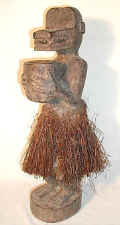
Figure of the monkey god Gbekre.
The Baule possess a figure with the head of a monkey representing one of the
humbler gods. It is called Gbekre or Mbotumbo, a god with
several tasks, for he is both judge of hell and helper of those in need,
protector of the living against their enemies. Theese so-called
“mendicant monkey” figures are very different in style of other Baule
sculptures. If the ancestor-cult statues are often characterized by refined
and detailed carving, the wood stained and often polished, the gbekre
are very different. They are roughly carved in unstained wood. They combine
human and animal traits in such a way that it is nearly impossible to
separate them. Besides, they are used for many different cults, for a trance
divination cult among them. Women are forbidden to see some of them, others
are openly shown.
Material: wood, rafia
Size: 20" x 6" x 6" |

Female bush spirit figure or mbra.
Around 1 million Baule occupy a part of the central Cote d’Ivoire that is
both forest and savanna land. They came to this territory in the 18th
century, an area previously the home of Guro.
Statues were mostly
used for two purposes: the first was to incarnate a spirit of the bush,
asie usu or mbra; the second was to represent a spouse from the
other world, blolo bla or blolo bian.
According to
the Baule beliefs,
Asie usu (mbra) are extravagant
creatures that live in the bush and occasionally make contacts with human
beings. They are male and female, have colorful personalities, and often
have personal names. Therefore their figures are made in pairs. These
spirits are mischievous, but, if properly honored, will grant fruitful
harvests and hunts. They sometimes express desire, through the village
diviner, to be associated with a specific person. A figure is then sculpted
and worshipped in the house of the designated individual. This figure is
outstanding by its size and quality.
Material: wood
Size: 80" x 16" x 14" |

Male bush spirit figure or mbra.
Baule
statues were mostly used for two purposes: the first was to incarnate a
spirit of the bush, mbra or asie usu; the second was to
represent a spouse from the other world.
According to
the Baule beliefs,
mbra live in the bush and occasionally
make contacts with human beings. They are male and female, have colorful
personalities, and often have personal names. Therefore their figures are
made in pairs. Mbra is a Baule cult used for divination. Only certain
families have mbra, having acquired it in past generation. These
spirits are mischievous, but, if properly honored, will grant fruitful
harvests and hunts. They sometimes express desire, through the village
diviner, to be associated with a specific person. A figure is then sculpted
and worshipped in the house of the designated individual. This figure is
outstanding by its size and quality.
Material: wood
Size: 75" x 16" x 13" |
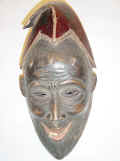
Mblo portrait mask. The Baule use three major
types of masks: a helmet in the shape of a buffalo head, masks related only
to the Goli festival and the masks representing a human face with
fairly realistic features. The masks of the last group are used in mblo
entertainment dances and are one of the oldest of Baule art forms. Such
a mask is usually a portrait of a particular known individual. Lustrous
curving surfaces, suggesting clean, healthy skin, are set off by delicately
textured zones representing coiffures, scarifications, and other ornaments.
The faces are idealized. Ornaments above the face have no iconographic
significance. These masks denote personal beauty, refinement, and a desire
to give pleasure to others. The greater importance of the portrait masks,
the need for the best dancers to wear them, and the requirement that the
portrait’s subject also be available and willing to dance made them more
rarely performed than animal masks, which could be worn by young, relatively
inexperienced dancers.
Material: wood
Size: 13" x 7" x 4" |
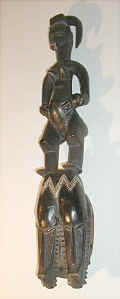 Double
mask with a female figure on top Double
mask with a female figure on top
Material: wood
Size: 34" x 6" x 4" |
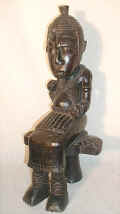
22" x 8" x 7" |
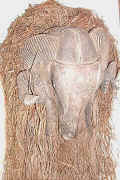
Goli ram mask.
Baule society was characterized by extreme individualism, great
tolerance, a deep aversion toward rigid political structures, and a lack of
age classes, initiation, circumcision, priests, and secret societies.
The Baule are agriculturists; yams
are the staple, supplemented by fish and game; coffee and cocoa are major
cash crops. The Baule use three major types of masks: a
helmet in the shape of a buffalo head, masks related only to the Goli
festival and the masks representing a human face with rounded, fairly
realistic features. The present mask relates to the second type. According
to the Baule mythology, the ram is a heavenly demon or a spirit of
agriculture. These masks are used on the occasion of the new harvest, at the
visit of dignitaries, or at the funerals of notables.
Material: wood
Size: 25" x 16" x 8" |
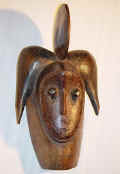 may not be baule16" x 9" x 5"
may not be baule16" x 9" x 5" |
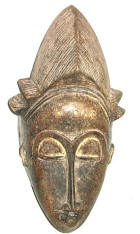
Mblo Mask
This
type of masks used in mblo dances is one of the oldest of Baule art
forms. These dances offer psychological relief in times of stress. The mask
is usually a portrait of a particular known individual. Lustrous curving
surfaces, suggesting clean, healthy skin, are set off by delicately textured
zones representing coiffures, scarifications, and other ornaments. The faces
are idealized.
Material: wood
Size: 49" x 9" x 7" |

Mankala (also called awele, wari or ma
kron) game. The game of mankala, though widespread, is
played more particularly in West Africa. It involves moving pawns on a board
with two rows of six holes. The goal is to capture the pawns in the opposite
row. The pawns can be made out of seeds, pebbles or pieces of metal. Many
ethnographical collections have mankala games, which are fine works
of art. This board is decorated with carved image of a crocodile. Two
parts. SOLD
Material: wood
Size: 49" x 9" x 7"
SOLD |
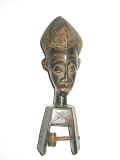
Weaver’s Pulley.
Weavers, always men, do not work in the courtyard but out in the public
place, often in an area where many weavers gather and every passerby greets
them. Their looms and weaving are watched and commented upon constantly.
Pulleys are made to be attractive and to make people talk about them and
their owner. Weavers said that a decorated pulley was simply for pleasure,
and that each sweep of the shuttle turned the pulley head from side to side,
as if it was shaking its head at the weaver.
Material: wood.
Size: 11" x 4" x 2"
|
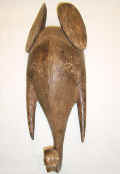
Goli Elephant Mask
Côte d'Ivoire, have played a
central role in twentieth-century Ivorian history. They waged the longest
war of resistance to French colonization of any West African people, and
maintained their traditional objects and beliefs longer than many groups in
such constant contact with European administrators, traders, and
missionaries.
The Baule are agriculturists; yams are the
staple, supplemented by fish and game; coffee and cocoa are major cash
crops. They use three major types of masks: the helmet masks in the shape of
a buffalo head, the masks representing a human face with rounded, fairly
realistic features, and the third type including masks related to the
Goli festival. The masks of the last type and in
particular elephant masks are used during the Goli festivities held
to celebrate new crops, the visit of dignitaries or periods of mourning. The
masks appear in suite, with animal forms, both domestic and wild, preceding
human face masks.
Material: wood
Size: 21" x 8" x 5" |
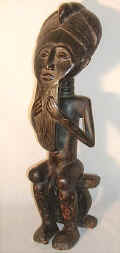 Male bush spirit figure or mbra.
Baule
statues were mostly used for two purposes: the first was to incarnate a
spirit of the bush, mbra or asie usu; the second was to
represent a spouse from the other world.
According to
the Baule beliefs,
mbra live in the bush and occasionally
make contacts with human beings. They are male and female, have colorful
personalities, and often have personal names. Therefore their figures are
made in pairs. Mbra is a Baule cult used for divination. Only certain
families have mbra, having acquired it in past generation. These
spirits are mischievous, but, if properly honored, will grant fruitful
harvests and hunts. They sometimes express desire, through the village
diviner, to be associated with a specific person. A figure is then sculpted
and worshipped in the house of the designated individual. Male bush spirit figure or mbra.
Baule
statues were mostly used for two purposes: the first was to incarnate a
spirit of the bush, mbra or asie usu; the second was to
represent a spouse from the other world.
According to
the Baule beliefs,
mbra live in the bush and occasionally
make contacts with human beings. They are male and female, have colorful
personalities, and often have personal names. Therefore their figures are
made in pairs. Mbra is a Baule cult used for divination. Only certain
families have mbra, having acquired it in past generation. These
spirits are mischievous, but, if properly honored, will grant fruitful
harvests and hunts. They sometimes express desire, through the village
diviner, to be associated with a specific person. A figure is then sculpted
and worshipped in the house of the designated individual.
Material: wood
Size: 22" x 7" x 5"
|
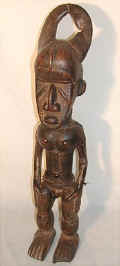 19" x 4" x 4" |
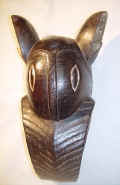
Material: Wood
Size: 23" x 13" x 8" |
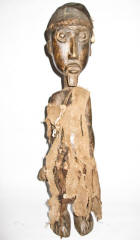
Materials: wood, fabric
Size: 18" x 4" x 4" |
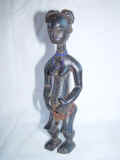
Material: wood
Size: 15" x 5" x 4"
|
|
BENIN
Nigeria
The powerful ancient Benin kingdom was founded by the son of an
Ife king in the early 14th century AD. It was situated in the forest
area of southern Nigeria, 106 miles southeast of Ife. The art of bronze
casting was introduced around the year 1280. The kingdom reached its
maximum size and artistic splendor in the 15th and 16th century. For a
long time the Benin bronze sculptures were the only historical evidence
dating back several centuries into the West African past, and both the
level of technical accomplishment attained in bronze casting, as well as
the monumental vigor of the figures represented, were the object of
great admiration. Benin bronzes are better known than the artworks from
Ife or Owo due to their presence in Western museums since 1890s. In the
thirteenth century, the city of Benin was an agglomeration of farms
enclosed by walls and a ditch. Each clan was subject to the oba
(king). The “Benin style” is a court art from the palace of the oba,
and has nothing in common with tribal art. The Benin oba employed
a guild of artisans who all lived in the same district of the city.
Bronze figures ordered by the king were kept in the palace. The empire
flourished until 1897, when the palace was sacked by the English in
reprisal for an ambush that had cost the British vice-consul his life.
The numerous commemorative brass heads, free-standing figures
and groups, plaques in relief, bells and rattle-staffs, small expressive
masks and plaquettes worn on the belt as emblem of offices; chests in
the shape of palaces, animals, cult stands, jewelry, etc. cast by Benin
metalworkers were created for the royal palace. The heads were placed on
the altars of kings, of brass caster corporation chiefs and dignitaries.
Occasionally, a brass head was surmounted by a carved ivory tusk
engraved with a procession of different obas. The altar
functioned as a tribute to the deceased and a point of contact with his
spirit. Using the bells and rattle stuffs to call the ancestor’s spirit,
the oba offered sacrifices to him and to the earth on the altar.
The majority of figures represented court officials, equestrian figures,
queens, and roosters. Of objects in ivory: most elaborately decorated
human masks, animals, beakers, spoons, gongs, trumpets, arm ornaments,
and large elephant tusks covered with bands in figured relief. The
representations of these objects served above all to exalt the king, the
queen mother, the princes and royal household, army commanders, shown
with their arms and armor and their retainers (huntsmen, musicians), or
alternatively depicted important events.
When British forces entered Benin City in 1897 they were
surprised to find large quantities of cast brass objects. The
technological sophistication and overwhelming naturalism of these pieces
contradicted many 19th-century Western assumptions about
Africa in general and Benin – regarded as the home of ‘fetish’ and human
sacrifice – in particular. Explanations were swiftly generated to cover
the epistemological embarrassment. The objects must, it was supposed,
have been made by the Portuguese, the Ancient Egyptians, even the lost
tribe of Israel. Subsequent research has tended to stress the indigenous
origins of West African metallurgy. Yet it was the naturalism that
proved decisive. Their status was marked by the establishment of the
term ‘Benin bronzes’, despite their being largely of brass.
Following the bloody British punitive expedition to Nigeria,
about three thousand brass, ivory and wooden objects were consigned to
the Western world. At that time, western scholars and artists were
stunned by the quality and magnificence of these objects, more than
1,000 brass plaques were appropriated from the oba’s palace.
Dating from the 16th and 17th centuries, these
plaques were secreted in a storage room. It is thought that they were
nailed to palace walls and pillars as a form of decoration or as
references to protocol. They show the oba in full regalia along
with his nobility, warriors and Portuguese traders. The most elaborate
ones display a procession of up to nine people, while others depict only
fish or birds.
The majority of everyday Benin objects were made for and
associated with court ceremonies. The figures of a leopard were the sole
property of the oba – the leopard was the royal animal.
Pectorals, hip and waist ornaments in the shape of human or animal heads
were worn either by the oba or by major dignitaries. Brass staffs
and clippers surmounted by birds appeared during commemorating
ceremonies.
Despite the disappearance of the Benin kingdom, the Yoruba people living
on its territory continued to produce artwork inspired by the great
royal art of Benin. |
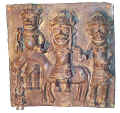
Benin style, Nigeria
Plaque with an oba.
When British forces entered Benin City in
1897 they were surprised to find large quantities of cast brass objects. The
technological sophistication and overwhelming naturalism of these pieces
contradicted many 19th-century Western assumptions about Africa
in general and Benin – regarded as the home of ‘fetish’ and human sacrifice
– in particular. The objects must, it was supposed, have been made by the
Portuguese, the Ancient Egyptians, even the lost tribe of Israel. Subsequent
research has tended to stress the indigenous origins of West African
metallurgy. Yet it was the naturalism that proved decisive. Their status was
marked by the establishment of the term ‘Benin bronzes’, despite their being
largely of brass. This plaque presents an oba (king) on the horse and
worriers.
Material: Benin bronze
Size: 15" x 14' x 3" |
|
BERBER
North Africa
“Berber” is the general name given to the indigenous peoples of North
Africa, whose cultures have survived in remote mountain and desert
regions, despite the Arabisation of the plains following the Islamic
conquest. The Berber languages are completely different from those of
the Semitic family, although many Berbers today speak both Berber and
Arabic. Most Berbers are Muslims, but there is a small Jewish minority.
Their traditional material culture is easily distinguished from the Arab
and Andalusian culture of the towns. In Morocco this Berber culture is
particularly rich and varied, and the inability of the central
government based in Fez, Meknes, Marrakesh or Rabat to control the
mountain peoples ensured that it flourished in relative isolation until
the French and Spanish colonial domination of the 20th
century.
|
| |

Bowl
Material: wood, metal stitches
Size: 6" x 12" x 2" |
|

Ladle
Material: wood
Size: 14" x 5"
|
|
|
BETE
Côte d'Ivoire
The Côte d'Ivoire is the home to the Bete -- they live in the
southwestern part of the country, between the Akan ethnic groups to the
east and the Guro tribe to the north. They number
about 700,000 and are an agricultural group.
Patrilinear, the Bete live – under the ancestors’
authority – in small “headless” villages. Historically they were
hunters, but nowadays they also farm. They grow what is needed for a
subsistence economy. They also have linked to the market economy and
much of their effort is devoted to the cultivation of cacao and coffee.
Religion, omnipresent in Bete life, aims to maintain a
harmonious relationship between nature and the ancestors who are
responsible for the welfare of the tribe. Today the vast majority still
follow their traditional African religion, believing in a creator God
Lago, but do not pray to or worship him. Instead they seek help from
many lesser spirits supposed to have supernatural power to help them, or
give protection--spirits of their ancestors, spirits that inhabit trees,
rivers, rocks, etc. They observe many customs and taboos and make
sacrifices of eggs, chickens, cows, etc.
Each ritual focuses on the maintenance and care of good
relations with the world of ancestors, so as to assure the protection of
the lineages. The religious cults give rise to numerous mask
performances, during the course of which the music assumes fundamental
importance. The apprenticeship of male youngsters particularly
concentrates on the mastery of these arts. In fact, within a village
context the men form into veritable dance societies, membership in which
is indispensable.
Bete carvers are renowned for one particular type of face mask,
the gre or nyabwa , which has exaggerated, grimacing
distorted features – a large protruding mouth, facial protuberances,
bulging forehead, elongated nose, with nostrils sometimes extending to
each side of the face, and globular or bulging slit eyes set beneath a
high-domed forehead carved with a medium ridge. In earlier days, this
mask presided over the ceremony held when peace was restored after armed
conflicts and it participated in sessions of customary justice. This
type of mask was also worn to prepare men for war; the masks offered
magical protection by instilling fear and terror in potential enemies.
Nowadays, it is worn for a variety of ceremonies, including
entertainment dances.
The Bete have carved elegant statues, stylistically influenced
by their neighbors the Guro. Bete statues were usually carved as
standing figures displaying set-apart legs, an elongated torso with
square shoulders, an elongated columnar neck supporting an oblong head
with a pointed chin, an incised mouth and a high-domed, smooth forehead
under a helmet-like coiffure. Bete figures exhibit hand positions, which
are difficult to interpret, as well as touches of white pigment. Male
and female figures are displayed in shelters or shrines to represent the
founders of the community. They incarnate the conceptual ideal of
spiritual perfection and moral strength and its connection to physical
beauty. Other smaller statuettes may have been carved to represent
spouses from the other world, a tradition inspired by the Baule.
|
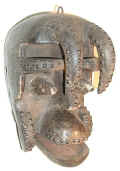
War mask. The Bete are an agricultural
group who live in relatively major
villages in southwestern part of the country, between
Bandama and Sassandra rivers.
They grow what is needed for a subsistence
economy and also have linked to the market economy and much of their effort
is devoted to the cultivation of cacao and coffee. They place particular
importance on the hunt. Religion,
omnipresent in Bete life, aims to maintain a harmonious relationship between
nature and the ancestors who are responsible for the welfare of the tribe.
Only the western Bete are known to
have a masking tradition. To
overcome hostile forces that hunters encounter in the underbrush and
forests, their masks offer magical protection by instilling fear and terror
in potential enemies. Masqueraders perform during burials,
at the end of the mourning period, or in honor of important people.
Sometimes they or one of their attendants carries a lance. This weapon
possibly points to the mask’s original function – that of a war mask.
Material: wood, tacks
Size: 13" x 9" x 9" |
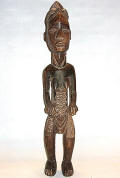
Ancestor statue (?). The Bete are
divided into ninety-three groups. Lacking centralized power, the Bete were
grouped together in relatively major villages, containing several lineages,
probably for security reason. Each lineage had a totemic animal whose meat
was taboo. The most senior member of the lineage exercised a moral and
judicial power, notably in terms of awarding land. Male and female figures
of this type are displayed in shelters or shrines to represent the founders
of the community. They incarnate the conceptual ideal of spiritual
perfection and moral strength and its connection to physical beauty. They
have specific functions associated with funerary rites.
Material: wood
Size: |
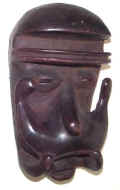
War mask. The Bete are an agricultural
group who live in relatively major villages in southwestern part of the
country, between Bandama and Sassandra rivers.
They grow what is needed for a subsistence
economy and also have linked to the market economy and much of their effort
is devoted to the cultivation of cacao and coffee. They place particular
importance on the hunt. Only the western Bete are known to
have a masking tradition. Even if
certain of their ritual attributions have disappeared or diminished, they
nonetheless remain effective mediators between the supernatural world and
that of man. The bellicose context of the masks’ appearances no longer
exists: they neither encourage nor lead men into battle; nonetheless, they
are always catalogued as war dance masks. Above all, they intervene to
ritually cleanse the village, detect and chase away sorcerers, or preside
over funerals.
Material: wood
Size: 11" x 8" x 4" |
|
BIJAGO
(ANAKI,
BIDJOGO, BIDYOGO, BIJOGO, BIJUGO, BISSAGO)
Guinea-Bissau
Off the shore of Guinea Bissau lie about thirty islands that
comprise the Bijago (Bissagos) archipelago. The Bijago are known from
early chroniclers' accounts for their daring raids on shipping along the
African coast using huge canoes. The economy of the archipelago is based
on the cultivation of rice, on palm oil, and on fishing. The society is
highly structured by means of institutions such as matrilinear clans,
the council of elders, age classes, and the priestess. Age groups cover
about seven levels among the males from infancy to old age. Martial
virtues were cultivated by an age-set system that associated young men
with powerful beasts of the sea and land. The Bijago society continues
to practice its many religious rituals. Among these, male initiations,
which today may not exceed two months, but formerly ran over several
years, and the women’s, which characteristically consist of offering
access to adult status for boys who have died before being initiated.
This is a recuperative initiation, performed by women who are possessed
by the spirit of the deceased. The matriarchal order was so strong that
the women selected their men and could force divorce on their husbands,
the man keeping the children.
The sculptor is a voluntarily engaged artisan who, through his
periodic activity in connection with ceremonies of initiation and
worship, is familiar with numerous secrets. Each villager may sculpt
initiation masks, head decorations, statuettes, vessels, and so on. The
heaviest masks are worn by the age group that is not yet considered
adult. These represent, in a realistic manner, marine animals or wild
bulls. While young boys might wear calf and fish masks, older
uninitiated youths wear those depicting wild bulls, sharks, hippopotami
and swordfish. Their dances are unpredictable and violent to accord with
the character of the animal represented and their own undomesticated
nature. The masks are worn either on top of the head or in front of it.
The dancers imitate these dangerous animals that symbolize beings that
are still untamed, as they have not been initiated. The masks are danced
by boys and young men during the ceremonies that precede and follow the
phases of initiation. Besides ritual occasions, nowadays they also
appear in secular contexts, on days that commemorate historical events,
and when important people visit.
Although Bijago figures can be realistic or abstract, they have
a head with a pointed chin, a flattened face often with rounded eyes and
semi-circular ears. These iran figures are believed to be
possessed by divinities and have many functions – they serve as the
focus of divination ceremonies, as protectors of households against
curses and as healers. Kept in small sanctuaries or in special places in
houses, these figures are offered sacrifices and libations, which may
create a thick patina on the surface. |
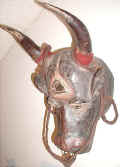
Wild bull (dugn’be) mask. Over
9,000 Bijago people inhabit the Bissagos islands. The economy of the
archipelago is based on the cultivation of rice, on palm oil, and on
fishing. The society is highly structured by means of institutions such as
the matrilineal clans, the council of elders, seven age classes and the
priestess. The majority of the Bijago practice animism. The women play a
major role in social life. The masks represent, in a realistic manner,
marine animals, hippopotamuses, sharks, or, like this one, wild bull.
The masks are worn either on top
of the head or in front of it. The dancers imitate these dangerous animals
that symbolize beings that are still untamed, as they have not been
initiated. The masks are danced by boys and young men during the ceremonies
that precede and follow the phases of initiation. The
heaviest masks are worn by the age group that is not yet considered adult.
Besides ritual occasions, nowadays
they also appear in secular contexts, on days that commemorate historical
events, and when important people visit.
Material: wood, horns, tissue
Size: 24" x 12" x 6" |
|
BOA
(ABABUA,
ABABWA, BABOA, BABUA, BABWA, BUA)
Democratic
Republic of the Congo
The Boa ethnic group comprises 200,000
savanna-dwelling people living in the northern part of the Democratic
Republic of the Congo. Each village is headed by a chief from the most
prestigious clan. The Boa are mainly farmers and are in frequent contact
with Mangbetu and Zande. The Boa are known principally for their masks,
believed to be used in war-related ceremonies, to enhance the warrior's
courage or to celebrate victories. These masks have set-apart,
prominent, round ears, suggesting alertness, and are covered alternately
with dark and light pigments. They have been described as belonging to
warrior or secret associations and are considered to be war masks or
disguises used in hunting although the precise function of Boa masks is
not known.
The Boa carve statues with apotropaic
functions. They also produce harps with human heads carved at the neck;
sometimes the harp body is completely sculptured as a male or female
figure. |
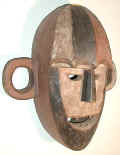
Protective spirit mask. The Boa live
between the Congo River and its right Oubangui tributary. The population of
this region is of Sudanese origin. Although the Boa tribe was influenced by
the Mangbetu, Boa works retain their originality. Only sparing information
about their masks’ use is available. Evidently they belonged to warriors
associations or secret societies and were used in the context of war dances.
Their power was thought to make men invincible and weaken the enemy. The
masks also protect society members from the dangers of illness, hunting,
evil spirits, etc. Wood rings in place of ears and red (or black) and white
contrasts are very typical for the Boa masks.
Material: wood
Size: 16" x 14" x 7" |
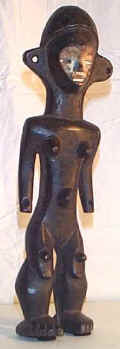
Protective figure. The Boa live in the
Aruwimi River region in northeastern part of the country. The population of
this region is of Sudanese origin. Although the Boa tribe was influenced by
the Mangbetu, Boa works retain their originality. The function of their
statues are apotropaic:
to protect society members from the dangers of illness, hunting, evil
spirits, etc.
Material: wood
Size: 14" x 4" x 3" |

Protective spirit mask. The Boa live
between the Congo River and its right Oubangui tributary. The population of
this region is of Sudanese origin. Although the Boa tribe was influenced by
the Mangbetu, Boa works retain their originality. Only sparing information
about their masks’ use is available. Evidently they belonged to warriors
associations or secret societies and were used in the context of war and
hunt dances. Their power was thought to make men invincible and weaken the
enemy. The masks also protect society members from the dangers of illness,
hunting, evil spirits, etc. Wood rings in place of ears and red (or black)
and white contrasts are very typical for the Boa masks.
Material: wood
Size:
21" x 11" x 3" |
|
BOBO
(BOBO-FING)
Burkina
Faso and Mali
In
the literature on African art they are often called the Bobo-Fing, but
they call themselves Bobo. Numbering 130,000 they live in eastern
Burkina Faso, and also in Mali. They are farmers. The major food crops
are sorghum, millet, yams, and maize. They grow cotton and peanuts as
cash crops. Their lives are regulated by a council of elders. The notion
of having a chief is profoundly foreign to them and they consider it to
be dangerous -- as waging a severe attack on the order of things as
established by the god. The Bobo god, creator of earth and animals, is
Wuro, who formed the world from a ball of mud. The first man created was
a blacksmith. Dwo, a son of the Wuro was responsible for helping
humankind. The blacksmiths were the priests of Dwo worship. Spirits of
the bush and ancestors received sacrifices. Dwo was the intermediary
between humankind and the creator; masks are the mainstay of tradition
and their meaning was revealed to young boys during their initiation
period. Living in a region of dry savannas where harvests depend on
rainfall, the Bobo instituted a series of purification rituals in order
to reconcile themselves with nature. Since it is proper to make amends
for the errors of humankind, masks have the essential function of
erasing evil and reinstating the God-given balance between sun, earth,
and rain. At the end of the dry season and before the work of
cultivation begins, purification ceremonies take place, using masks of
leaves, of fiber and wood, which may represent Dwo or protective
spirits: warthog, male buffalo with flat horns, rooster with its crest
standing perpendicular to its face, toucan, fish, antelope, serpent, and
hawk. All of them incarnate the forces of fertility, fecundity, and
growth. The masks symbolize animals or spirits and are worn during
ceremonies associated with new crops, initiations and funerals. Among
the Bobo, the sacredness of the mask derives from the fact that the
divinity is considered to be present in the mask and, through it to be
acting. The wearer is depersonalized to the advantage of the mask that
he animates. To be a “mask”, man had to erase himself, that is to say,
cease to be himself, shed his individuality. The Bobo also cast bronze
pendants and statues.
|
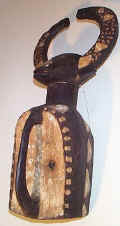
Horned-animal mask.
The Bobo numbering 100,000 to 130,000 live
mostly in eastern Burkina Faso. A council of elders regulates their lives.
The notion of having a chief is profoundly foreign to them and they consider
it to be dangerous -- as waging a severe attack on the order of things as
established by the god. Masks are
the mainstay of tradition and their meaning was revealed to young boys
during their initiation period. Masks have the essential function of erasing
evil and reinstating the God-given balance between sun, earth, and rain. At
the end of the dry season and before the work of cultivation begins
purification ceremonies take place, using in particular masks, which
represent the protective spirits of the village. All of them incarnate the
forces of fertility, fecundity, and growth. The masks different in various
areas symbolize animals or spirits and are worn during ceremonies associated
with new crops, initiations and funerals.
Material: wood
Size: 31" x 12" x 8" |
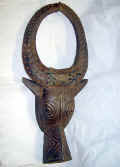
Antelope mask.
The Bobo live mostly in eastern Burkina Faso. They are surrounded on the
east by the Mossi, on the south by the Senufo and the Lobi, on the west by
the Bamabara, and on the north by the Dogon. This ethnic group has produced
a very marked and distinguished artistic style.
Masks are the mainstay of tradition and
their meaning was revealed to young boys during their initiation period.
Masks have the essential function of erasing evil and reinstating the
God-given balance between sun, earth, and rain. At the end of the dry season
and before the work of cultivation begins, purification ceremonies take
place, using in particular masks, which represent the protective spirits of
the village. All of them incarnate the forces of fertility, fecundity, and
growth. The masks different in various areas symbolize animals or spirits
and are worn during ceremonies associated with new crops, initiations and
funerals. Typical are square jaws and concentric rings that indicate the
eyes.
Material: wood
Size: 31" x 12" x 9"
|
|
BULE (BULU)
Cameroon and Gabon
Occupying the border region between Cameroon
and Gabon, the Bulu form part of the Fang group and live not far from
Kwele, with whom they share cultural similarities. They practiced a
ngi ritual against sorcery, in particular, against poisonings.
Ngi is the gorilla, a fearful animal, with whom the candidate
identifies after he has been accepted into the association. The
inventiveness of their round, simple forms is striking, and artists have
captured with great precision the animal posture.
Most of their masks are in the form of a
human face, some with horns. They have geometrically formed human heads,
mostly colored white and black.
|
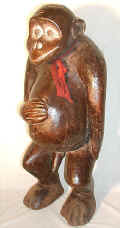
Gorilla (ngi) ritual figure.
Occupying the border
region between Cameroon and Gabon, the Bulu form part of the Fang group and
live not far from Kwele, with whom they share cultural similarities. They
practiced a ngi ritual against sorcery, in particular, against
poisonings. Ngi is the gorilla, a fearful animal, with whom the
candidate identifies after he has been accepted into the association. The
specific function of this figure in the ngi ceremony is not known.
Material: wood
Size: 24" x 12" x 13" |
|
BWA
(BOBO-OULE, BOBO-ULE, BWABA,
BWAMU)
Burkina
Faso and Mali
Numbering 125,000 in Mali and 175,000 in
Burkina Faso, the Bwa are divided in three endogamous castes: farmers,
blacksmiths, and griots (bards and musicians). The Bwa are farmers who
grow grain, especially millet, sorghum and maize. They have grown very
large amounts of cotton since the colonial period, and the cultivating
of this cash crop has contributed to the destruction of their
traditional patterns of cooperative farming. Agriculture is practiced
primarily by the men, women participating on certain occasions only. The
blacksmiths forge tools and cast brass, and their wives make pottery.
The blacksmith is also the village’s gravedigger and is responsible for
digging wells. He is thus the man in contact with the soil; this
indicates his importance, his role as mediator in disputes and as
intermediary with the supernatural world. The griots weave and dye
cotton. They play an important social role and are essential in public
events. The Bwa have no centralized political organization and every
village is directed by a council of the eldest men of the lineages.
The spiritual life of the Bwa is based on
worship devoted to Do (Dwo) and the founding ancestors of the clan. Do
is at once an organization and an anthropomorphic being, the son of the
creator god. Do represents the life-giving powers of nature, the forest
and nourishing forces, sources of the life of plants and the fields, and
intervenes at the time of agrarian rituals and funerals. Do is
incarnated at initiations and village purifications, held just after
crops are planted, by an otherworldly spirit masker whose “skin” is
vines, grasses, and leaves. Deliberately non-human in shape, color, and
behavior, the maskers celebrate life and help renew the forces of
nature.
Wooden masks are found only among the Bwa
in the south. The eyes set off by concentric circles, for instance, are
intended to recall an owl, and the hooked shape extending from its
forehead alludes to the hornbill. These masks represent animals:
antelopes, warthogs, wild buffalo, monkeys, crocodiles, serpents, fish,
birds, and insects, along with some human beings, and bush spirits who
take on supernatural forms. The motifs are symbols linked to Do and to
the history of the clan. The mask is worn in front of the face. They are
differentiated only by the shape of the horns, while the muzzle and
protruding eyes remain the same structure. The dancer looks through the
open hole of the mouth. These masks are thought to be inhabited by
supernatural forces, who act to benefit the clan possessing them. The
Bwa carve also polychrome masks in horizontal shapes, which symbolize
butterflies or hawks. The butterfly mask is decorated with concentric
circles, while the hawk mask has a plain white surface. Masks are
involved in burials, at the end of periods of mourning, in initiations,
and for entertainment festivities on market days. Bwa figures are
relatively rare and are associated with divination ceremonies and human
and agricultural fertility rites. They are paraded through villages and
are offered sacrifices. The Bwa sculpt divination canes with curved
ends; diviners use copper or brass bracelets decorated with standing
figures that represent the spirits. |
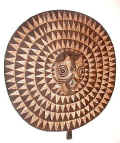
Nature Spirit plank mask. Over 300,000 Bwa people are
scattered across Burkina Faso and Mali. The Bwa are farmers who grow grain,
especially millet, sorghum and corn. They are classified into professional
castes: farmers, blacksmiths and musicians. They have a rich masking
tradition. The northern Bwa primarily use masks made of leaves, feathers,
and plant fibers. The southern Bwa also have various types of wooden masks,
which they adopted from the neighboring Gurunsi people and from the original
Bobo. Representing spirits of nature, which influence human life, the
maskers appear on market days, during initiations, funerals, harvest rites,
and on other festive occasions. This mask is marked by a high degree of
abstraction. Yet the Bwa associate some of the compositional elements with
certain birds that play a role in the spirit world. The eyes set off by
concentric circles, for instance, are intended to recall an owl.
Material: wood
Size: 33" x 31" x 5" |
| |
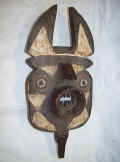
Antelope mask. The southern Bwa are
called nyanegay, or “scarred Bwa” because their faces and torsos are
heavily scarred by patterns applied during initiation. The southern Bwa
abandoned the use of leaf masks to honor Do, the god of the wilderness, and
adopted the use of wooden masks from their Gurunsi neighbors. The masks
represent nature spirits or animals that family elders encountered in the
wilderness and which watch over their families.
They may represent antelopes, warthogs,
wild buffalo, monkeys, crocodiles, serpents, fish, birds, and insects, along
with some human beings, and bush spirits who take on supernatural forms.
Both the scars on people’s faces and the patterns on the
masks represent the moral code or religious laws that the followers of these
spirits must obey if they are to receive the blessings of the spirit.
A mask has a rather circular face
with geometric designs painted in vivid colors. The eyes set off by
concentric circles are intended to recall an owl. The motifs are symbols
linked to Do and to the history of the clan. The mask is worn in front of
the face. The dancer looks through the open hole of the mouth. These masks
are thought to be inhabited by supernatural forces, who act to benefit the
clan, that possess them.
Material: wood
Size:
20" x 9" x 6" |

Hawk plank mask (bougou dinde).
The southern Bwa adopted the use of wooden masks from their Gurunsi
neighbors. The Bwa masks represent nature spirits or animals that family
elders encountered in the wilderness and which watch over their families.
They may represent antelopes,
warthogs, wild buffalo, monkeys, crocodiles, serpents, fish, birds, and
insects, along with some human beings, and bush spirits who take on
supernatural forms. Both the scars on people’s faces and the
patterns on the masks represent the moral code or religious laws that the
followers of these spirits must obey if they are to receive the blessings of
the spirit. The mask is worn in
front of the face. The dancer looks through the open hole of the mouth.
The hawk mask dances energetically. The geometric designs
convey coded information to the initiates, and meaning vary by clan and
level of initiation.
Material: wood
Size:
62" x 13" x 4"
|
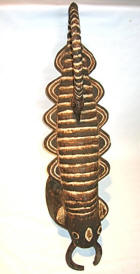
Material: wood
Size: 43" x 11" x 20"
|

Nwantantay plank mask. The southern Bwa are
called nyanegay, or “scarred Bwa” because their faces and torsos are
heavily scarred by patterns applied during initiation. The southern Bwa
abandoned the use of leaf masks to honor Dwo, the god of the wilderness, and
adopted the use of wooden masks from their Gurunsi neighbors. The masks
represent nature spirits or animals that family elders encountered in the
wilderness and which watch over their families.
They may represent antelopes, warthogs,
wild buffalo, monkeys, crocodiles, serpents, fish, birds, and insects, along
with some human beings, and bush spirits who take on supernatural forms.
Both the scars on people’s faces and the patterns on the
masks represent the moral code or religious laws that the followers of these
spirits must obey if they are to receive the blessings of the spirit.
A mask has a circular face with
geometric designs painted in vivid colors, and is surmounted by a large
plank with a crescent-shaped motif at the end. The eyes set off by
concentric circles are intended to recall an owl, and the hooked shape
extending from its forehead alludes to the hornbill. The motifs are symbols
linked to Dwo and to the history of the clan. The mask is worn in front of
the face. They are differentiated only by the shape of the “horns”, while
the muzzle and protruding eyes remain mostly the same. The dancer looks
through the open hole of the mouth. These masks are thought to be inhabited
by supernatural forces, who act to benefit the clan, that possess them.
Material: wood
Size: 56" x 18" x 6"
43" x 11" x 20" |
|
CAMEROON GRASSLAND (BAMUM, BAMELIKE, etc.)
The northern part of Cameroon has been
Islamized and has no sculpture; on the other hand, the savannas of the
west, the Grassland, are composed of three ethnic groups with ancestors
in common. There are the one million Bamileke spread over the
southwestern plateaus, in communities that have from 50,000 to 100,000
people; the 500,000 Bamenda-Tikar in the north; and, finally, the Bamum
in the northwest, with a population of 80,000. The Bamileke resisting
slave raids with suicide or rebellion, contributed very little to the
Black population of the New World. The artistic production of the people
living in the Grassland of Cameroon is closely associated with royal and
societal ceremonies. Large figures, thrones and prestige paraphernalia
are used by the king to assert his power.
The Grassland was divided into ninety kingdoms
governed by a king, the fon, supported by non-secret societies.
In the past, he was believed to be endowed with supernatural powers that
allowed him to change into an animal – an elephant, leopard, or buffalo.
He ensured the protection of his people and guaranteed the fertility of
the fields and the fecundity of the women. The fon was
responsible for rituals of planting and harvesting, for the annual
festival of the dry season, for the opening of the collective royal
hunt, and for expeditions of war. The fon was appointed by his
predecessor, who chose him from among his direct heirs, excluding the
eldest. Art objects were symbols of position in the hierarchy; their
number, the materials from which they were made, and their iconography
changed progressively as one descended or ascended the social ladder.
Competition among sculptors was often great, for the artist’s “office”
was not hereditary. Sculpture’s goal was to commemorate and celebrate
the royal ancestors of the present fon. In the fon’s
palace, next to the ancestral figures and the masks, one would also find
headdresses, beaded thrones, bracelets, necklaces, pipes, leopard skins,
elephant tusks, swords, commanders’ sticks, fans, dishware, horns, and
terracotta bowls.
In Bamileke (Mbalekeo, Mileke)
territories, the fon entrusted the guardianship of the sculptures
to certain members, for to spread around portions of the treasury was an
insurance against the frequent fires. Masks that elicit fear and
apprehension are the work of societies responsible for repression. In
spite of the ethnic and stylistic variations found in the Grassland
area, similar types of mask have been produced. All young boys belong to
associations based on age classes, covering periods of five years each,
focusing on military and technical apprenticeship. The various societies
also had their masks; some of them, according the tradition, had been
created and consecrated by the ancestors themselves, others inspired
great fear, there were masks decorated with beads, copper, and cowrie
shells. Most of the kingdoms used the buffalo, stag, elephant, birds
masks, and masks presenting male and female human heads. They are
usually worn during state ceremonies such as the funeral of an important
dignitary, or during annual festivities. During these ceremonies, the
leading dancer wears a n’kang mask which bears a false beard, a
coiffure split in two symmetrical parts and is often covered in royal
paraphernalia such as cowrie shells and beads. The n’kang mask is
followed by other masks representing a woman, a man or an animal. The
buffalo and elephant masks represented strength and power, and the
spider mask, intelligence, but most of the meanings are now lost.
Bamum (Bamoum, Bamoun, Bamun, Banun,
Mom, Mum, Mun) social life was oriented toward the conquest of
surrounding chieftainries, and forays were made into neighboring lands:
from this stems a warrior mythology and an abundance of material symbols
of strength. The Bamum produced large figures encrusted with beads and
cowries. Noteworthy elephant heads cast in bronze. There are also: dance
masks in the form of a long head and a high neck, also in animal-head
form; footstools and thrones decorated and supported by animal or human
figures. In the small kingdom of Bangwa, the heads of statues and masks
feature puffed-out cheeks. The very characteristic sculpture in the
round attains its apogee in a depiction of a horn-player who wears
traditional headgear in the shape of a tiara; the thick double arc of
his eyebrows overhang, and the mouth is treated in parallelepipedal
relief under a heavy nose featuring well-shaped nostrils.
The wood used for masks is not always
completely hollowed out, for the mask does not cover the face of the
wearer but rather tops a kind of bamboo cage surrounded by a tufted
collar of palm fibers, which conceals the head. These masks, instruments
of societies with political, administrative, judicial, or theatrical
functions, were kept in special storage houses; they were brought out at
the first rainfall. Then, the king himself would appear masked and
dancing. The buffalo joins the leopard, elephant, and two-headed python
as an image of royal power is frequently found in the decoration of
works from the region.
A large number of prestigious items of
paraphernalia were produced within the Grassland area, including large
house-posts, door and window frames carved with human and animal
figures, thrones, stools and tables decorated with small heads and
figures, large bowls, carved horns for royal feasts, anthropomorphic
terracotta and bronze pipes. Musical instruments such as anthropomorphic
and zoomorphic drums, as well as metal gongs, were played during royal
and state ceremonies. |

Elephant shaped Box for medicines. The
grassland region, in south-west Cameroon, is a hilly and mountainous area
covered by an equatorial forest in the south and a savannah in the north.
The area is divided into 90 small independent kingdoms and chiefdoms, whose
powers are counterbalanced by male and female societies. Apparently, this
box was intended for medicinal herbs. The elephant Babanki style
decorating the box like leopards are two of the most prevalent symbols of
dynastic power in Cameroon royal art.
The elephant represented strength and power,
lizards represent household tranquility.
Material: wood
Size: 37" x 12" x 13" |
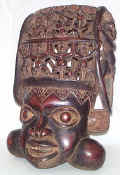
Ceremonial Royal Mask. The northern
part of Cameroon has been Islamized and has no sculpture; on the other hand,
the savannas of the west, the Grassland, are composed of three ethnic groups
with ancestors in common. The Grassland is divided into 90 small independent
kingdoms and chiefdoms, whose powers are counterbalanced by male and female
societies. The Grassland Region is a hilly and mountainous area. All young
boys belong to association based on age classes, covering periods of five
years each, focusing on military and technical apprenticeship. This mask
tops a kind of bamboo cage surrounded by a tufted collar of palm fibers. The
large masks of this type with a complex design on top were specifically used
during the royal festivities held within the king’s palace. Up to thirty
different masks might perform in an event.
Material: wood
Size: 31" x 22" x 19" |

Material: wood
Size: 20" x 8" x 8"
|
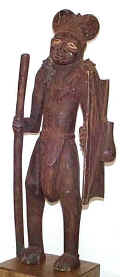
Figure of a King. The Cameroon
Grassland is a large cultural area, which is inhabited by many related
peoples. The Bangwa, like most of the people in this area, are historically
farmers who grow maize, yams, and peanuts as staple crops. They also raise
some livestock, including chickens and goats, which play an important role
in daily sustenance. Women, who are believed to make the soil more fruitful,
are responsible for the tasks of planting and harvesting the crops. Men are
responsible for clearing the fields for planting and practice some nominal
hunting. The Bangwa also developed trade relations with their neighbors
living in southeastern Nigeria. The hierarchical societies of the Cameroon
Grassland support a wide range of leadership and prestige arts associated
with royalty and persons of high rank. This figure represents a Bangwa royal
ancestor, whose high status is emphasized by the knotted prestige cap. The
sculpture would have been kept in the royal treasury along with many other
objects reserved for use by the Fon, the political ruler of a Grassland
kingdom. Palace art is displayed during royal funeral ceremonies, public
appearances by the Fon, and annual festivals.
Material: wood
Size: 40" x 17" x 13"
|
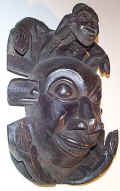
Ceremonial Royal Mask. The Grassland
Region is a hilly and mountainous area. The northern part of Cameroon has
been Islamized and has no sculpture; on the other hand, the savannas of the
west, the Grassland, are inhabited by three ethnic groups with ancestors in
common and keeping old traditions. The Grassland was divided into ninety
kingdoms each governed by a king, the fon. In the past, he was
believed to be endowed with supernatural powers that allowed him to change
into an animal – an elephant, leopard, or buffalo. He ensured the protection
of his people and guaranteed the fertility of the fields and the fecundity
of the women.
This mask tops a kind of bamboo cage surrounded by a
tufted collar of palm fibers. The large masks of this type with a complex
design on top were specifically used during the royal festivities held
within the king’s palace. Lizards
represent household tranquility.
Material: wood
Size: 21" x 12" x 14"
|
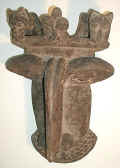
Ceremonial Royal Mask.
In Bamileke (Mbalekeo, Mileke)
territories, the fon (king) entrusted the guardianship of the
sculptures to certain members, for to spread around portions of the treasury
was an insurance against the frequent fires. Masks that elicit fear and
apprehension are the work of societies responsible for repression. In spite
of the ethnic and stylistic variations found in the Grassland area, similar
types of mask have been produced. Since the masks were usually carved by
foreigners who had been brought into the kingdom as prisoners of war, these
performances also served to integrate populations from the defeated lands
into the kingdom. This mask is topped with figures of leopards that are
royal animals and symbols of dynastic power in Cameroon
royal art.
Material: wood
Size:25" x 13" x 12" |
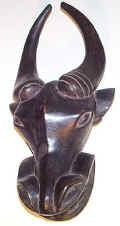
Buffalo mask. The most important
Cameroon grasslands kingdom in the south is the Bamileke circle (Batcham,
Bandjoun, Bangwa, and others). There are one million Bamileke spread over
the plateaus, in communities that have from 50,000 to 100,000. Art objects
were symbols of high position in the hierarchy. The buffalo’s physical power
and endurance was viewed as a particularly appropriate metaphor for the
force of palace law. The buffalo masks were worn by palace regulators in
their roles as market police, apprehenders of wrongdoers, and court judges.
According to S. P. Blier, “Some of the masked performers were
perceived to be so wild and dangerous that they had to be restrained by
ropes to prevent them from doing harm, a display that would have reinforced
the original functions of these court maskers in punishing those guilty of
criminal acts”.
Material: wood
Size:
26" x 16" x 7"
|
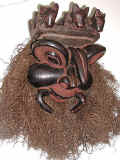
Ceremonial Royal Mask.
In Bamileke (Mbalekeo, Mileke)
territories, the fon (king) entrusted the guardianship of the
sculptures to certain members, for to spread around portions of the treasury
was an insurance against the frequent fires. Masks that elicit fear and
apprehension are the work of societies responsible for repression. In spite
of the ethnic and stylistic variations found in the Grassland area, similar
types of mask have been produced. Since the masks were usually carved by
foreigners who had been brought into the kingdom as prisoners of war, these
performances also served to integrate populations from the defeated lands
into the kingdom. The mask is topped with figures of leopards that are royal
animals and symbols of dynastic power in Cameroon royal art.
Material: wood, rafia
Size: 23" x 12" x 14" |
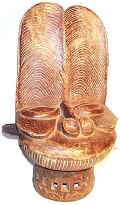
Batcham
headdress.
Batham is a small Bamileke kingdom in the northwest region of the Grassland.
Its name was given to this kind of headdresses, although they were very
popular also among the Bangwa and the Bamileke. In these chiefdoms, power
was held by the Fon, a king who was supported by powerful
brotherhoods or societies. Batcham masks belonged to one of these societies
and were designed to intimidate and to maintain social order. They were used
mainly for the enthronement or the burial of the Fon or notables. It
could also be seen during a special dance that was only performed at the
royal residence to the sounds of ritual pipes. This ceremony marked the end
of the harvest and the coming of new year. Certain
authors see this mask as a totally unrealistic depiction of a hippopotamus
head emerging from the water.
Material: wood
Size: 30" x 20" x 7" |
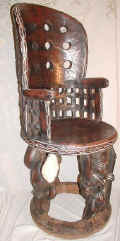
Prestige Stools. Among the kingdoms of
the Grassland, stools decorated with beads or made with bronze were usually
reserved for the fon or his noblemen.
Material: African bronze
Size: 49" x 20" x 20"
|
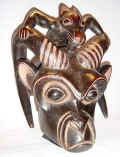
Ceremonial Royal Mask. The northern part of Cameroon has been
Islamized and has no sculpture; on the other hand, the savannas of the west,
the Grassland, are composed of three ethnic groups with ancestors in common.
The Grassland is divided into 90 small independent kingdoms and chiefdoms,
whose powers are counterbalanced by male and female societies. All young
boys belong to association based on age classes, covering periods of five
years each, focusing on military and technical apprenticeship. This mask
tops a kind of bamboo cage surrounded by a tufted collar of palm fibers. The
masks of this type with a complex design on top were specifically used
during the royal festivities held within the king’s palace. Up to thirty
different masks might perform in an event.
Material: wood
Size: |
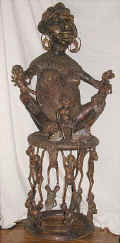
Commemorative Figure. The Bamum live in the west of the
country and are numbering some 80,000. The sultanate of Bamum is ruled by a
single, sacred king, known as the Fon. He is assisted by three officials and
seven hereditary councilors. The Fon and his court is a focal point of the
tribe, and exert powerful influence upon the development of the plastic art,
although it must be remembered that Cameroon has hundreds of chiefdoms. The
art of Cameroon is the art of a royal court with a complex protocol and
numerous rituals. This commemorative figure of a queen with her children
came from the Bamum territory of the Grassland. The theme of maternity often
expressed in the art of many African tribes underlines not only its narrow
subject, but also contains ideas of fecundity and fertility of the earth.
Material: African bronze
Size: 56" x 25" x 20"
|

Prestige Stools. Among the kingdoms of the Grassland, stools
decorated with beads or made with bronze were usually reserved for the
fon or his noblemen.
Material: African bronze
Size: 16" x 12" x 12" each |
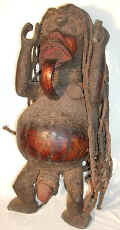
Material: wood,
Size: 28'
x 13" x 14" |
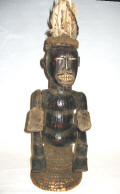
Father Heaven headdress with moving hands.
The Ejagham are found in the easternmost part of southern Nigeria and in
the contiguous area of the western Cameroon. They are primitive
agriculturists and their main crops are yam, coconut and maize. The Ejagham
produced
skin-covered wooden headdresses and masks of a demonic naturalism. Earlier
skins of slaves, later skins of antelopes, were used. It is presumed that
all masks and headdresses represented ancestors. They have mythological
significance: male images representing Father Heaven, female Mother Earth.
The Ejagham masquerades performances generally took place at the initiation
or funerals of members of the associations, and also at periodic rites
connected with agriculture. The skin covering the headdress served as a
magical agent to invoke ancestral spirits, thus eroding the barrier between
living and dead participants in communal rituals.
Material: wood, antelope
skin, vegetable fiber, feathers
Size: 23" x 8" x 8"
|
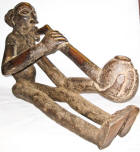 32" x 21' x 13" |

Palace box. The 80,000 Bamum people
inhabit the savanna (Grassland) in the west of the country. The sultanate of
Bamum is ruled by a single, sacred king, known as the fon. He is assisted by
three officials and seven hereditary councilors. The fon and his court is a
focal point of the tribe, and exerts powerful influence upon the development
of the plastic art, although it must be remembered that Cameroon has
hundreds of chiefdoms. The art of Cameroon is the art of a royal court with
a complex protocol and numerous rituals. This unusual box of outstanding art
work and presenting some mythological subject came from the Bamum cultural
area; it was intended to be used in some palace ceremonies.
Material: wood, beads, cowries
Size: 34" x 31" x 20"
|
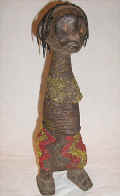
Doll. The northern part of Cameroon has
been islamicized and has no sculpture; on the other hand, the savannas of
the west, the Grassland, are composed of ethnic groups with ancestors in
common. Among them there are more than 1 million Bamileke spread over the
southwestern plateaus, in communities that have from 50,000 to 100,000. The
dolls held by young Bamileke and Namji women are carved from wood which is
then heavily decorated with fine beadwork.
Material: wood, beads
Size: 17" x 6" x 3" |
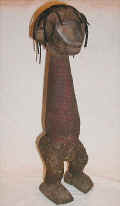
Doll. The northern part of Cameroon has
been islamicized and has no sculpture; on the other hand, the savannas of
the west, the Grassland, are composed of ethnic groups with ancestors in
common. Among them there are more than 1 million Bamileke spread over the
southwestern plateaus, in communities that have from 50,000 to 100,000. The
dolls held by young Bamileke and Namji women are carved from wood which is
then heavily decorated with fine beadwork.
Material: wood, beads
Size: 18" x 5" x 4" |
|
CAMEROON (NORTH) |
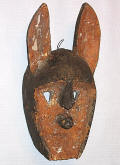
Face rabbit (dyommo) mask. The
area identified as Dogon country spans roughly 19,300 square miles of
southeast Mali, with a population of approximately 400,000. The history of
Dogon masquerade has been one of constant adaptation. Mask performances were
described in connection with post-burial rites for important elders, rites
for the protection of fruit crops, and at corrective rites, referred to as
puro, curbing the behavior of women. This mask type represents a
rabbit (dyommo), and its wearer danced to rhythms known by the same
name.
Material: wood
Size: 10" x 5" x 4" |
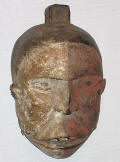
Face mask. The Ogoni live to the east of
the Niger delta, in a fertile area rich in petroleum resources. Despite the
efforts of Christian missionaries, they have retained a vital, regionally
varied masquerading activity that is in part deeply rooted in their own
tradition and in part adopted from neighboring ethnic groups such as the
Ibibio or Ijo. Ogoni mask acrobatic dances named karikpo serve a
great variety of functions, which, depending on the region, can extend from
pure entertainment to participation in funeral services and harvest
festivals, all the way to the implementation of judicial verdicts. The
present mask with its movable lower jaw, full lips, and short nose,
represents a classical type of Ogoni mask. Some sources associate this type
of mask with the performances held before the yam harvest celebrations.
Dressed in costumes made of fresh foliage, groups of masqueraders moved
through the lanes and farms from morning to night, repeatedly performing
exuberant dances and receiving from lookers small gifts of money, food, or
beverages.
Material: wood
Size: 7" x 4" x 3"
|
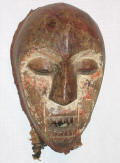
Material:
Size: 7" x 5" x 4"
Lega mask |
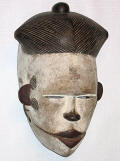
Face woman mask. The Ogoni, who live
east of the Niger Delta, use numerous types of masks for entertainment or on
ceremonious occasions. Some of these originate from their own carving
traditions, others from neighboring peoples such as the Ijo or Ibibio. The
repertoire includes anthropomorphic face masks with movable lower jaw. Masks
of the Ogoni people are generally smaller than those of the Ibibio, but
share with them similar features such as hinged jaws. The masks wre danced
by young men, dressed in costumes of fresh leaves and various types of mask,
including the classical one with movable jaw and zoomorphic masks. Delicate
coiffures usually signify femininity; horns, masculine power.
Material: wood
Size: 11" x 7" x 6" |
| |
|
|
|
|
|
Total
items this page |
101 |